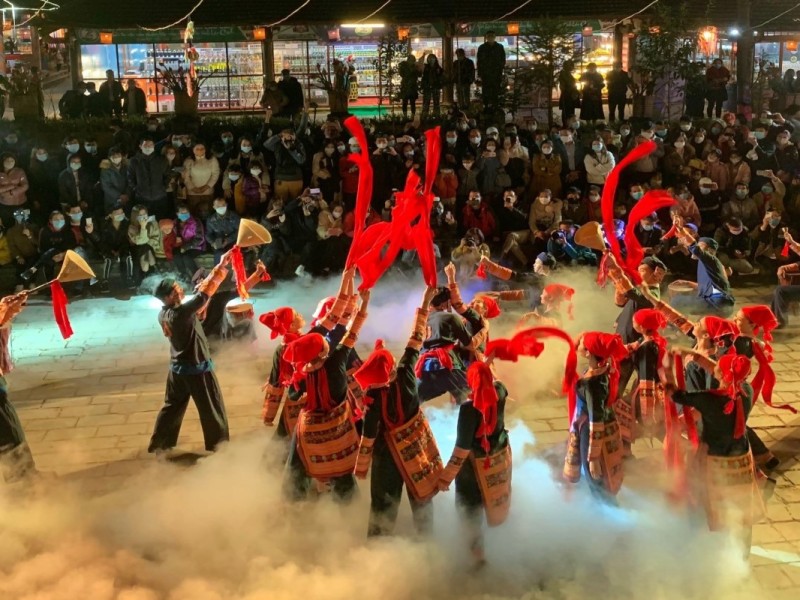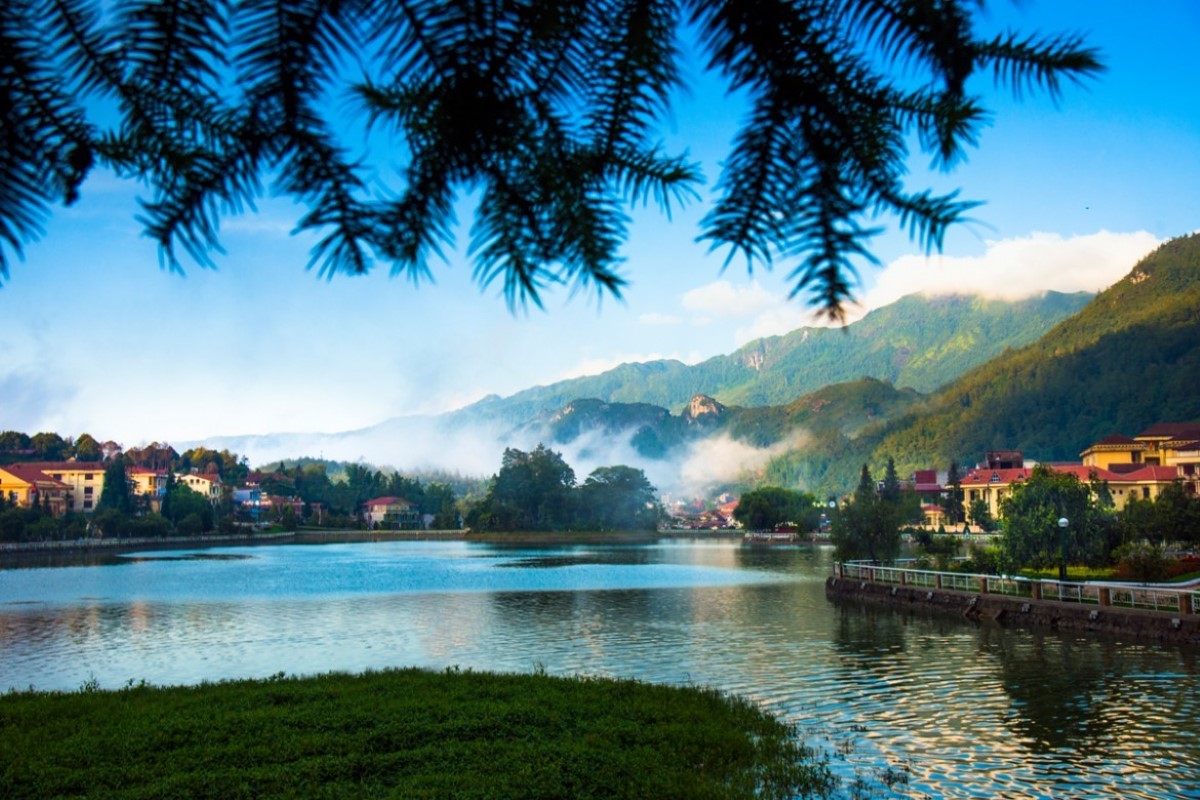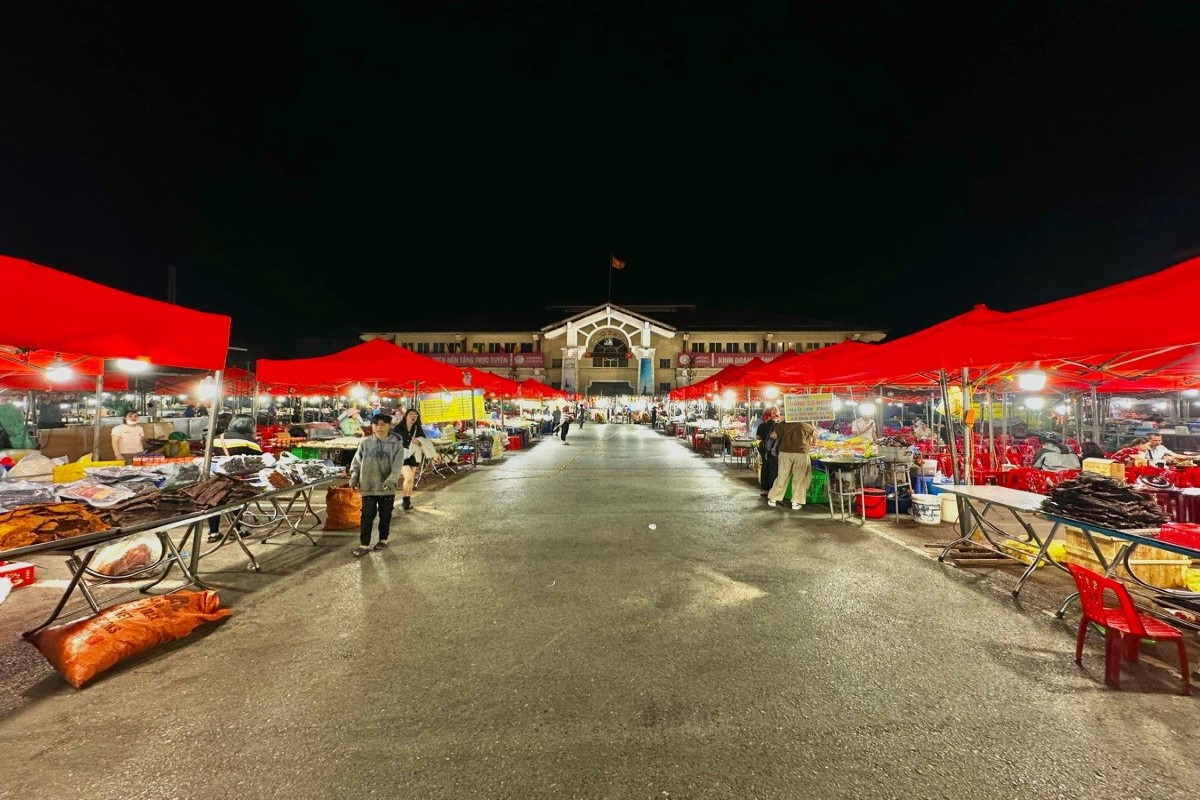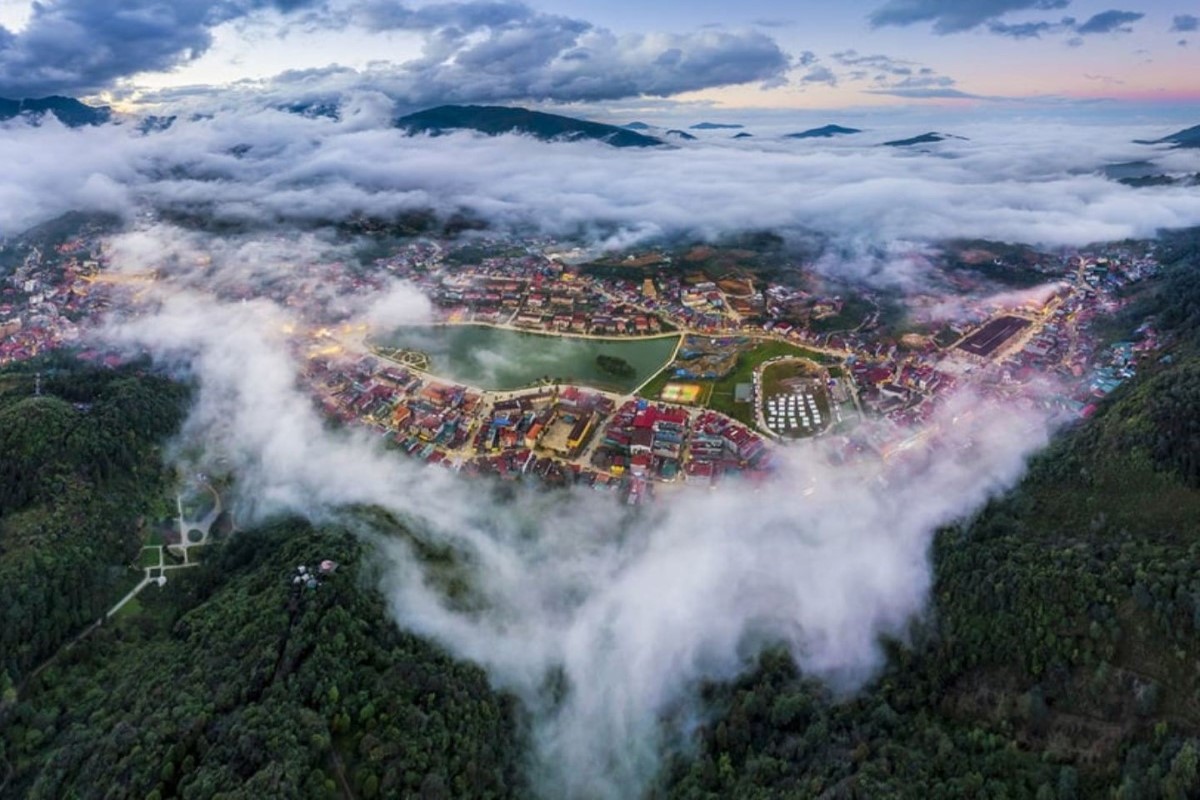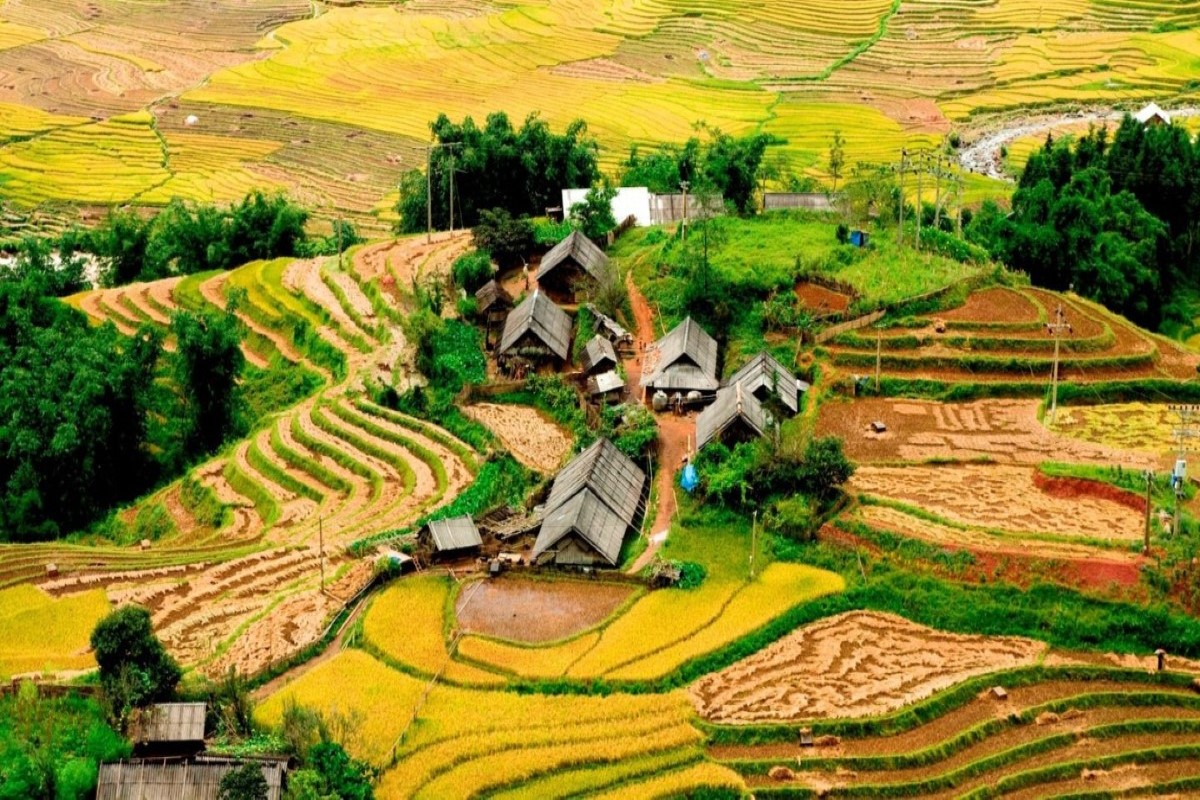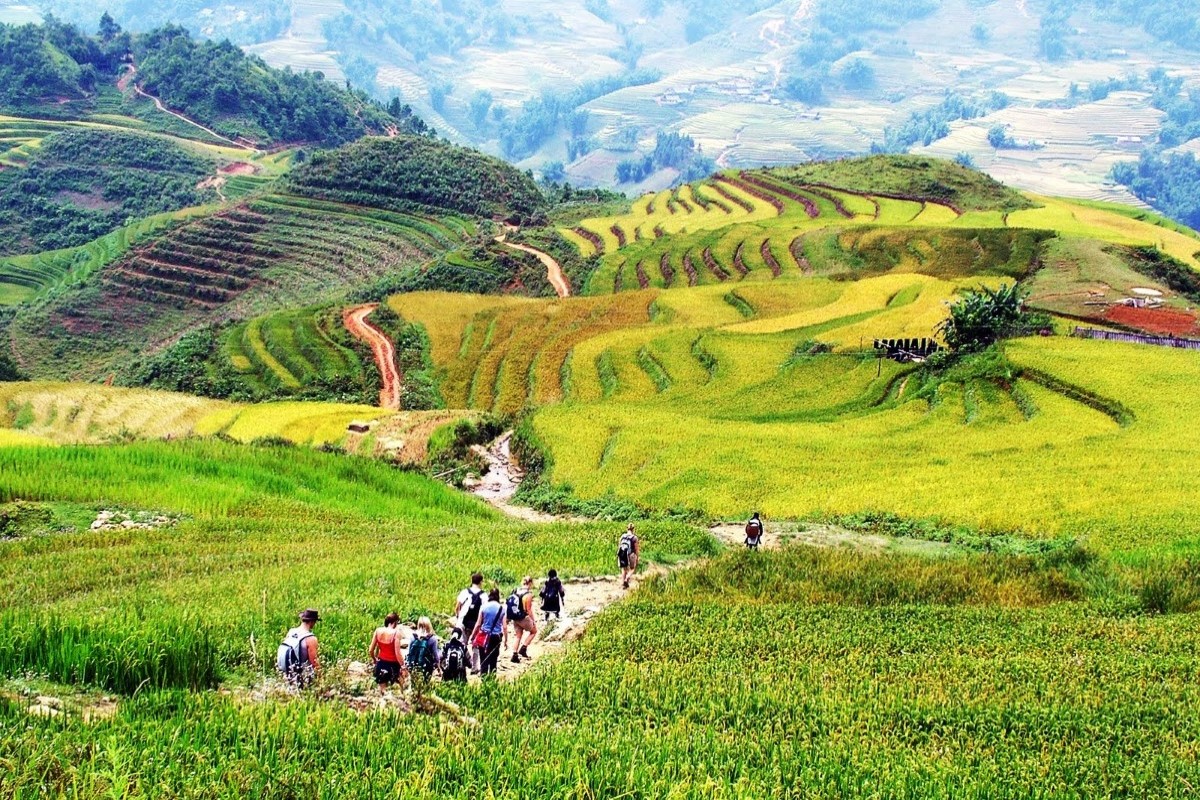Stone Church Sapa: History, Culture & Top Things to Do for Visitors
Stone Church Sapa is a historic Roman Gothic landmark in the center of Sapa, Vietnam. The church offers visitors striking stone architecture, vibrant local culture, and scenic mountain views. It stands out for its blend of French colonial heritage and its role as a gathering place for the town’s diverse communities.
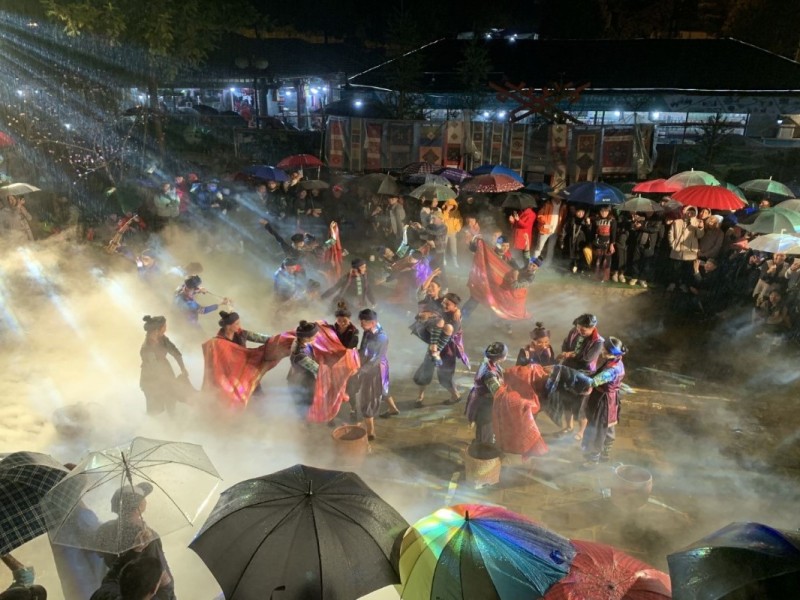
Step Inside the Heart of Sapa – Meet the Stone Church Sapa
Nestled in the center of vibrant Sapa Town, the Stone Church Sapa rises with quiet dignity beside the bustling square and dramatic mountain backdrop. For many travelers, this historic church is more than a place to admire—it’s a true symbol of Sapa, a landmark you’ll sense in local stories and daily rhythms alike. Whether you’re drawn by its striking stonework or its deep-rooted presence in the heart of town, the church is where history and modern life meet. Here, you step straight into the pulse of Sapa.
The first thing you notice is how the church sits at the crossroads of the town’s cultural life. Framed by mists and the vibrant tapestry of ethnic markets, its presence is a constant—visible from almost every angle in the main square. Wanderers, vendors, and local families weave past as the bells mark the hours, grounding this highland town with the quiet strength of tradition. For anyone seeking a sense of place in Vietnam’s far north, the Stone Church Sapa is where your journey should begin.
If you’re hoping to experience the true heart of Sapa, make sure this landmark tops your itinerary. Plan a stop here to soak in the view, discover the stories behind its walls, and set out on your exploration of the town’s rich history. For custom guides or insider tips, reach out to us at Asia Travel Links—we’re here to help you discover what makes this spot truly unforgettable.
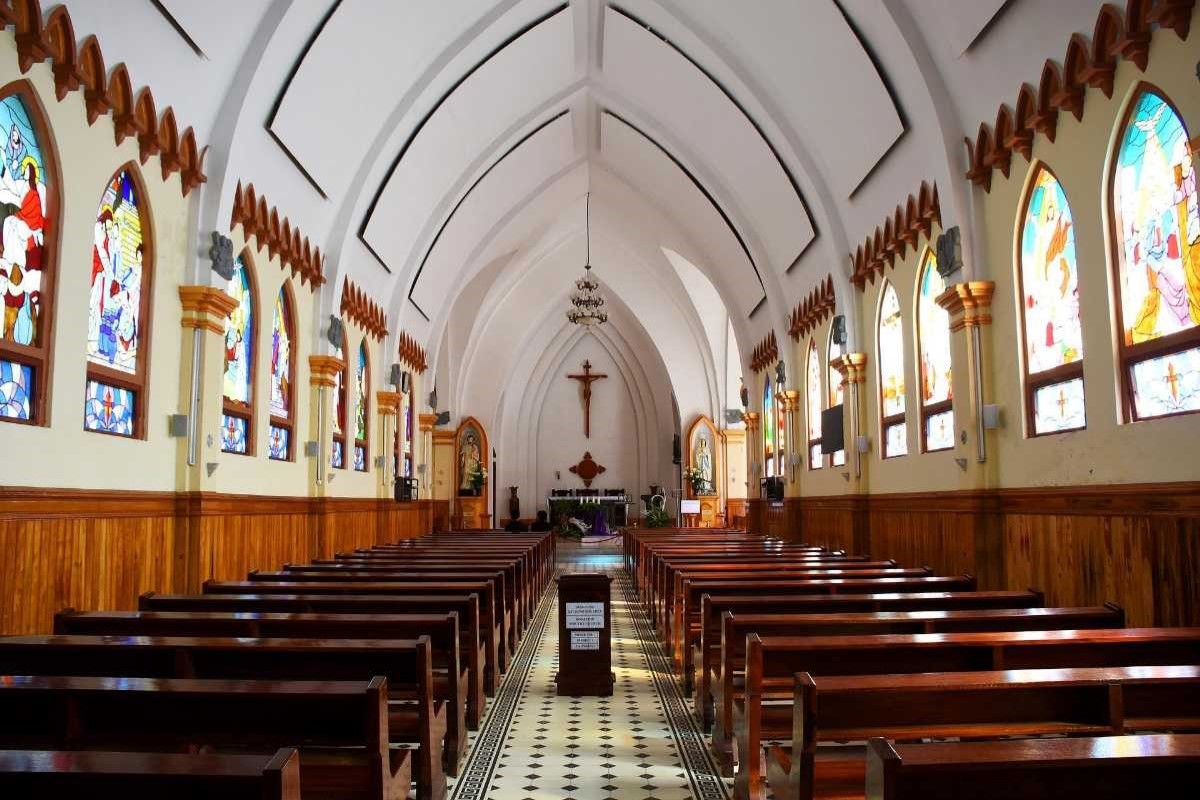
What Makes Stone Church Sapa So Special?
Step into the square and you’ll quickly see why the Stone Church Sapa stands out as one of the region’s most iconic landmarks. The church blends the architectural grandeur of old Europe with the everyday vibrancy of Sapa’s market life. Whether you’re gazing up at its bell tower or watching local children play on the steps, the site feels alive—carrying centuries of faith, community, and history.
For visitors, the draw is as much about atmosphere as it is about detail. The architecture of Stone Church Sapa is instantly striking, a unique fusion of Gothic architecture Sapa and local design. Every element, from the rosette window to the worn stone threshold, whispers of stories past and present. As you explore, take a moment to watch how sunlight shifts over the arched windows, and listen for the echo of market voices blending with the soft chimes from the bell tower. This place is the definition of a must-see attraction in northern Vietnam.
To truly appreciate what makes the Stone Church Sapa special, be sure to visit during the golden hours, when the square glows and the town’s diverse communities come together. If you want to uncover more hidden gems or arrange a guided walk, email us at Asia Travel Links for personalized recommendations.
Unique architectural highlights you’ll notice right away
The design of the Stone Church Sapa captures your eye from the moment you approach, with features that set it apart from any other building in the region.
- Bell tower Sapa: The slender bell tower rises high above the square, ringing out over the rooftops and marking the center of town.
- Arched windows: Graceful, pointed arches in classic Gothic architecture Sapa style invite both light and curiosity into the main hall.
- Stone facade (laterite): Weathered, warm-hued stone walls give the church a timeless strength, blending with the mountain landscape.
- Rosette window: Above the entrance, a circular window of colored glass draws the gaze—an artistic focal point in the facade.
- Carved details: Subtle motifs on the doorways and walls nod to both European craftsmanship and local influences.
Each of these features creates an atmosphere that’s equal parts historic and inspiring. Visitors often find themselves lingering outside, camera in hand, capturing the shifting light and unexpected beauty in every detail. If you’re a fan of architecture or simply love great photography, plan to spend time soaking in these highlights—and reach out to Asia Travel Links for photo tips and the best angles around Sapa.
Why this church is the soul of Sapa town
At the very center of Sapa town square, the Stone Church Sapa is far more than a tourist stop—it’s where the lifeblood of the community pulses. For generations, this spot has been the backdrop to everything from festival parades and weekend markets to daily meetups between friends and neighbors. The church’s open forecourt invites locals and travelers alike to pause, gather, and share a moment together.
What makes it especially meaningful is how seamlessly the church fits into the tapestry of local life Sapa. On any given day, you might see Hmong, Dao, or Tay women in traditional dress passing by, children playing tag after school, or market vendors chatting before setting up their stalls. This living heritage transforms the church from a historic site into the beating heart of the town—a symbol of Sapa’s enduring spirit and unity.
If you want to truly connect with Sapa, start by spending time at its soul. Bring a coffee to the square, watch the world go by, and let the stories of this remarkable place unfold. For insights on market days or festival schedules, visit Asia Travel Links or call us for the latest updates.
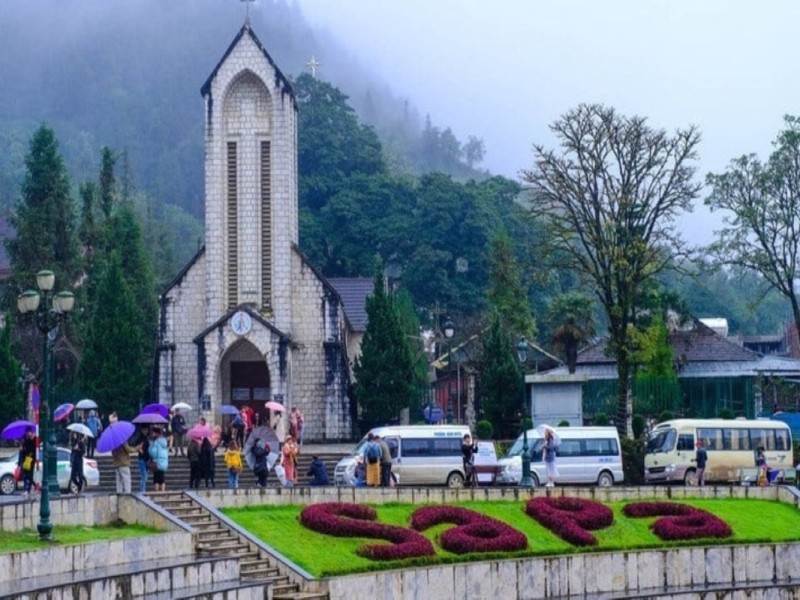
Quick Facts Every Visitor Should Know
You don’t need to be a seasoned traveler to make the most of your time at Stone Church Sapa. With just a few essential facts, you can plan your visit smoothly and avoid last-minute surprises. Below are the practical details every visitor needs for a stress-free experience.
Exact location, address, and how to find it
Finding the Stone Church Sapa is easy—it sits right in the heart of Sapa Town, surrounded by iconic landmarks and bustling daily life.
- Full Address: 1 Nhà Thờ Street, Sapa Town, Lào Cai Province, Vietnam
- Google Maps Coordinates: 22.3345° N, 103.8419° E
- Nearby Landmarks: Just steps from Sapa Square and opposite Sun Plaza, making it an unmistakable focal point in town
- Getting There: Most visitors arrive on foot from their hotel, as the church is within easy walking distance from the main market, bus station, and many guesthouses
- Context: If you reach Sapa Square or see the colorful dome of Sun Plaza, you’re less than a minute away
The central location of Stone Church Sapa means you’ll naturally encounter it as you explore. If you ever get lost, simply ask a local for directions to the “old church” or look for the crowds near Sapa Square and Sun Plaza. For a custom map or advice on the best walking routes, email us at Asia Travel Links anytime.
Practical info for first-time visitors (hours, entry, accessibility)
Before you go, check these practical details to ensure a smooth visit to Stone Church Sapa.
- Visiting hours Stone Church Sapa: Exterior accessible daily, typically 6:00 AM to 9:00 PM. Interior access may be limited to service times or special occasions.
- Entry fee Stone Church Sapa: Free to view and photograph from the outside. Entry for Mass or special events may have a modest fee or donation.
- Accessibility Sapa: Ramps at the main entrance allow basic wheelchair and stroller access, but some areas have steps or uneven paving. Assistance may be needed for interior access.
- Crowds: Early morning and late afternoon are the quietest times, with midday and weekends attracting the most visitors.
- Other tips: Bring a light jacket, as the weather can shift quickly. Respect services and local gatherings, and avoid flash photography inside.
Armed with these details, you’ll be ready for a relaxed and enjoyable experience at the church. If you have questions about specific access needs or want to know about special events, just call us or reach out through Asia Travel Links for up-to-date local advice.
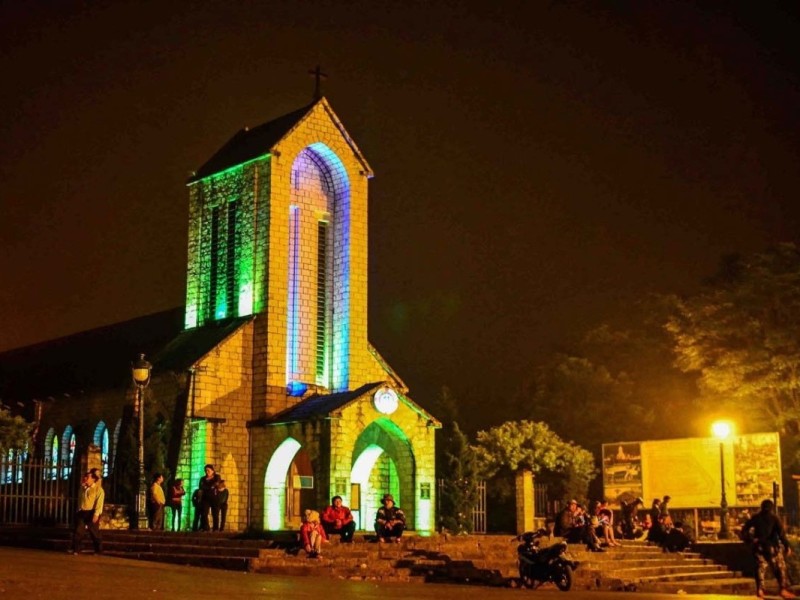
A Welcoming Place for All Travelers
When you visit Stone Church Sapa, you’re not just seeing a monument—you’re stepping into a vibrant community hub where every traveler and local is welcome. This isn’t a quiet relic roped off from real life. Instead, it’s a place where energy, diversity, and the spirit of Sapa come together every day. No matter when you stop by, you’ll find yourself drawn into the rhythm of the town and its people, from early-morning vendors to wandering families and curious tourists.
How both locals and visitors use the church today
The church square is where Sapa’s stories unfold in real time. On any given day, you’ll see groups of locals gathering for casual conversation, kids dashing around in spirited games, and elders enjoying the calm. Local life Sapa is always in motion here, with vendors selling snacks, flowers, or handcrafts just outside the main steps.
For visitors, Stone Church Sapa is both a meeting point and a perfect spot to snap photos that capture the essence of town life. Tourists often pause here to orient themselves before exploring the markets or nearby mountain trails. It’s common to see backpackers comparing notes over coffee, while families gather for a group selfie with the iconic stone facade behind them.
What truly makes this place special is the genuine interaction—no matter where you’re from, you’re invited to be a part of the daily scene. Take a few minutes to soak up the lively atmosphere, or join the flow of people headed off to explore more of Sapa. For even more tips on connecting with the local vibe, reach out to Asia Travel Links for personal suggestions.
Why it’s a gathering point for Sapa’s diverse communities
There’s a powerful sense of togetherness around Stone Church Sapa, especially during festival weekends and market days. The church square becomes a living crossroads, drawing people from all corners of town and the surrounding villages. Here, you’ll spot Hmong, Dao, and Tay women in traditional clothing mingling with travelers, sometimes selling their handmade goods or simply sharing stories beneath the colorful market umbrellas.
These moments reveal the multicultural heart of Sapa. Events at the church are not just religious gatherings—they are lively celebrations where music, laughter, and cultural traditions blend. During the Love Market or major festivals, you can watch ethnic minorities Sapa showcase their crafts, enjoy traditional music, or join in the joyful bustle that fills the square.
For travelers eager to experience authentic Hmong Dao Tay Sapa culture, the church is the ideal place to witness daily life in all its colorful diversity. If you want to know the schedule for festivals or the best times to see these vibrant gatherings, call us or check in with Asia Travel Links for local event updates.
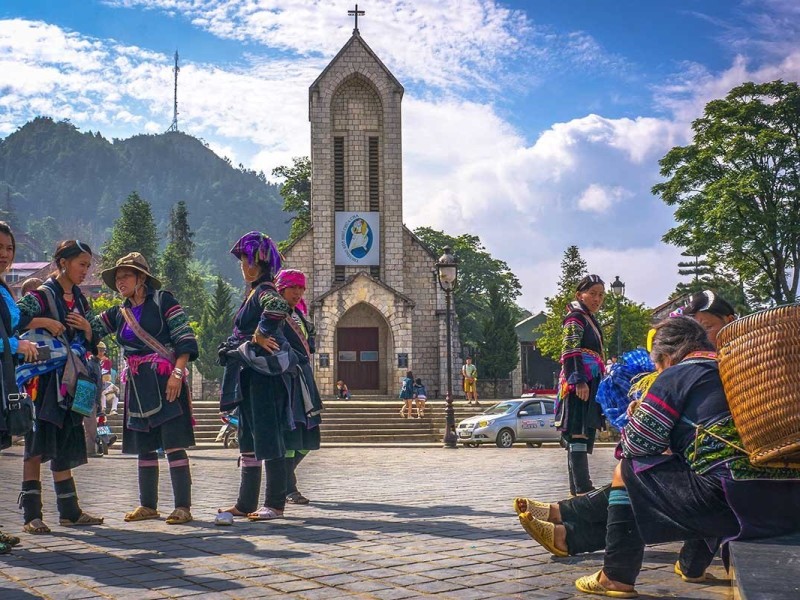
Discover the Fascinating History Behind Stone Church Sapa
Beneath the misty peaks of northern Vietnam, the story of Stone Church Sapa unfolds with a richness that sets it apart from other Sapa landmarks. Travelers curious about the origins of this historic church quickly find themselves drawn into a narrative that reflects the evolution of Sapa itself—from a remote highland outpost to a vibrant cultural crossroads. Each stone, each echoing bell, speaks of eras gone by and the people who shaped them. To stand before the church today is to witness living history—a testament to resilience, community, and architectural artistry that endures across generations. Discovering the backstory behind Stone Church Sapa not only builds your appreciation but brings you closer to the spirit of this extraordinary region. Let us help you trace its journey, then plan your own at Asia Travel Links.
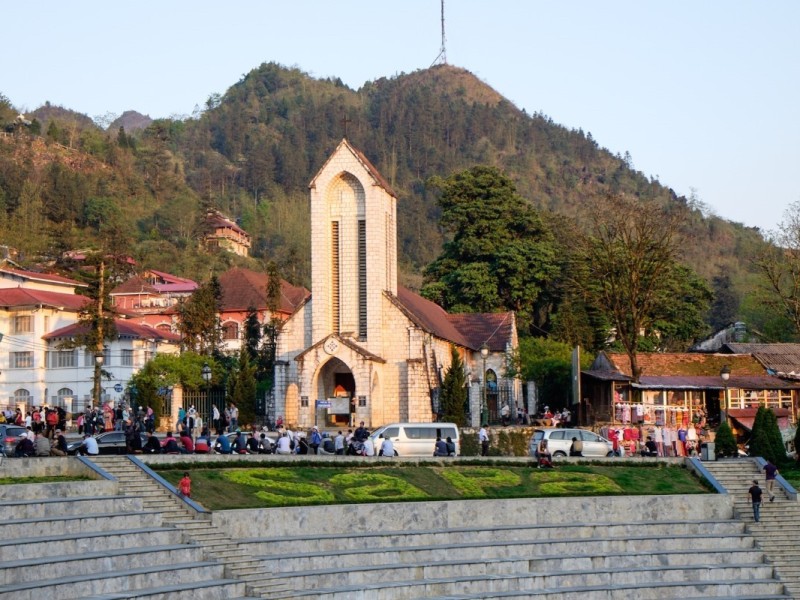
From French Colonial Days to Sapa’s Iconic Landmark
The story of Stone Church Sapa begins with the ambitions of the French colonial era. Built at a time when Sapa was first attracting the interest of explorers and missionaries, the church quickly established itself as an anchor in town. What started as a Catholic mission Sapa in the early 20th century has survived countless transitions—colonial rule, local conflicts, and economic shifts—becoming a beloved Sapa landmark and symbol of cultural adaptation.
As you walk its grounds, you feel the layered stories underfoot. The echoes of foreign architects mingle with the rhythms of local festivals, reminding visitors of the church’s ability to withstand the test of time. Today, it stands as both a relic of the French colonial history Sapa and a vibrant heart of the community, connecting past and present for all who visit. If you want to experience this sense of history firsthand, reach out to us at Asia Travel Links for guided explorations into Sapa’s living heritage.
Key dates and milestones in the church’s story
Understanding the timeline of Stone Church Sapa helps you appreciate every detail in its weathered stone.
- Construction date Stone Church Sapa: Built in 1935 during the height of the French colonial presence in Sapa, with laterite stone and imported materials.
- Purpose in French colonial history Sapa: Originally designed as a Catholic mission Sapa, serving both European settlers and local converts.
- War and neglect: The church endured the upheaval of wars, periods of closure, and stretches of disrepair during the 20th century.
- Renovation and revival: In the late 1990s and early 2000s, the church underwent careful restoration, reclaiming its place as a cherished symbol and active place of worship.
- Modern recognition: Now a protected historic site, the church is celebrated as a central part of Sapa’s cultural and tourism identity.
Each milestone deepens the church’s significance, from colonial ambition to community resilience. If you’re eager to witness these layers of history in person, plan your trip with Asia Travel Links and explore with local insight.
The church’s changing roles throughout Sapa’s history
The adaptability of Stone Church Sapa is as impressive as its architecture. What began as a Catholic mission Sapa soon evolved, responding to the shifting tides of history. During turbulent decades, the church’s bell fell silent more than once, but its sturdy walls remained a silent witness to the town’s struggles and hopes.
Over time, the site transformed from a religious stronghold into a beloved Sapa landmark—hosting community gatherings, celebrations, and even cultural events that bring together visitors and locals alike. Today, the church stands not only as a reminder of colonial roots but as a living symbol of Sapa’s unity, hospitality, and vibrant festival spirit. Its journey from mission to meeting place makes every visit a chance to be part of an ongoing story.
If you’re curious about how the church continues to shape local traditions and celebrations, let us know at Asia Travel Links. We’d be delighted to guide you deeper into the evolving legacy of Stone Church Sapa.
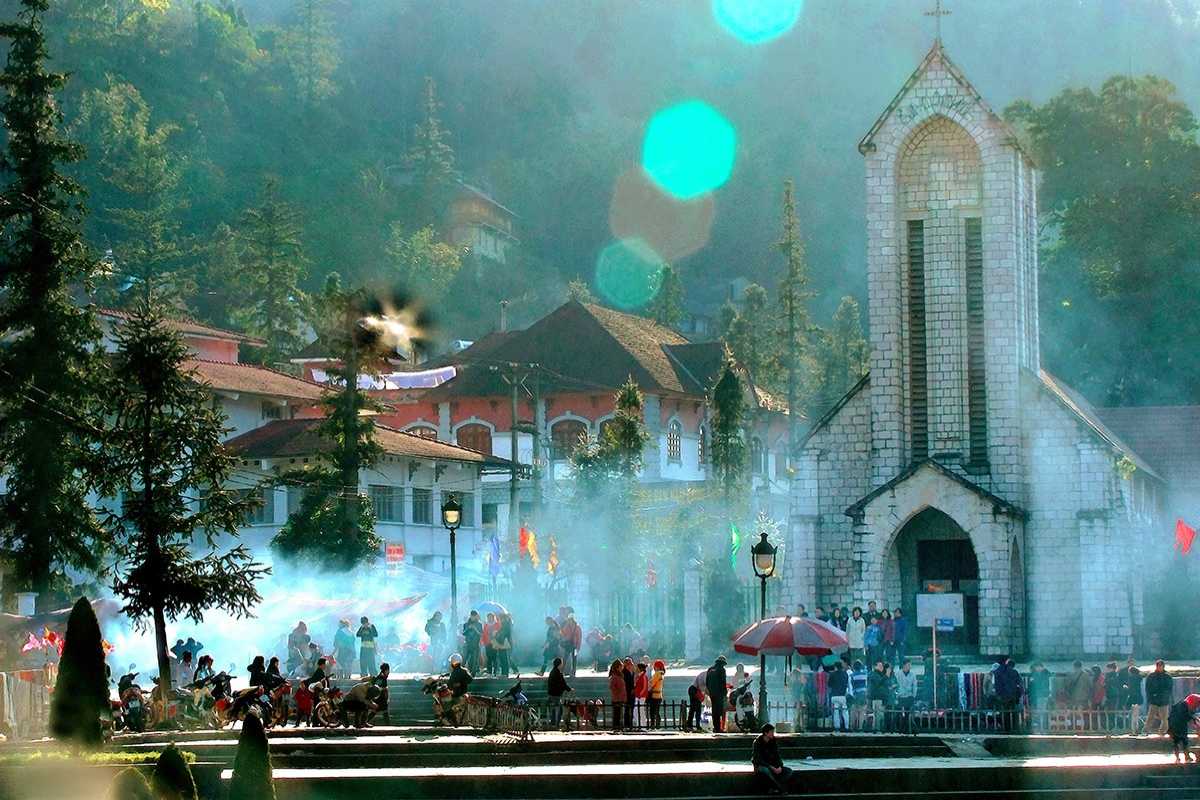
Secrets in the Stone – Exploring the Church’s Architecture
You don’t need to be an architect to be captivated by the design of Stone Church Sapa. Every wall, window, and arch has a story to tell, drawing the eye to details that many visitors miss on a casual walk-by. If you’re the kind of traveler who loves to look closer, you’ll find that the church is a treasure chest of symbolism, skilled craftsmanship, and local legend. The blend of style and storytelling here reveals not just the talents of its builders, but the spirit of Sapa itself. Next time you approach, pause and look for the secrets carved into the stone—you might just see the landmark in a whole new way. For more behind-the-scenes insights or guided walks, email us at Asia Travel Links.
Hidden details and stories in the design
Many of the most intriguing aspects of Stone Church Sapa are right there in the open, waiting to be discovered by attentive visitors.
- Church carvings Sapa: Intricate designs and subtle patterns are etched above the main doors, said to be inspired by both French artistry and the motifs found in Sapa’s traditional textiles.
- Inscriptions: Look for Latin phrases and dates, which hint at the church’s origins and its ties to colonial builders.
- Unique construction: Unlike most buildings in the region, the church uses a core of locally sourced laterite and stone, chosen for their durability in Sapa’s mountain climate.
- Folklore and mystery: Some locals believe certain stones near the base bring good luck, a piece of Sapa folklore passed down through generations.
- Legends: One story tells of a craftsman who hid a personal symbol among the carvings, challenging future visitors to spot it.
These hidden elements invite curiosity, turning every visit into a mini treasure hunt. If you enjoy unearthing stories, take your time to explore these details—and ask a local or guide about their favorite secret. When you’re ready to dig deeper, contact us at Asia Travel Links for more local legends and exclusive tours.
Blend of European Gothic and local influences
The magic of Stone Church Sapa lies in how it marries two worlds: the soaring forms of Europe and the grounded, resourceful spirit of Sapa.
- Gothic architecture Sapa: The church’s pointed arches Sapa and ribbed vaults are classic examples of European Gothic design, brought here by colonial architects.
- Local building materials Sapa: Unlike stone cathedrals elsewhere, this church is built primarily from native stone and laterite, materials hand-picked for their endurance in the local climate.
- Subtle adaptations: The steep roof is designed to shed heavy rains and mountain mists, while the thick walls insulate against the chill.
- Artisanal touches: The windows and door frames were crafted by local artisans, blending Vietnamese techniques with imported blueprints.
- Harmonious design: The result is a landmark that feels at home in both the mountains of Sapa and the tradition of grand European churches.
The fusion of Gothic architecture Sapa with local ingenuity makes this building a true original. Every angle tells a story of cultural blend and adaptation—one that you can see and feel for yourself. Want to learn more about this unique artistry? Ask Asia Travel Links for a custom architecture walk or deeper exploration.
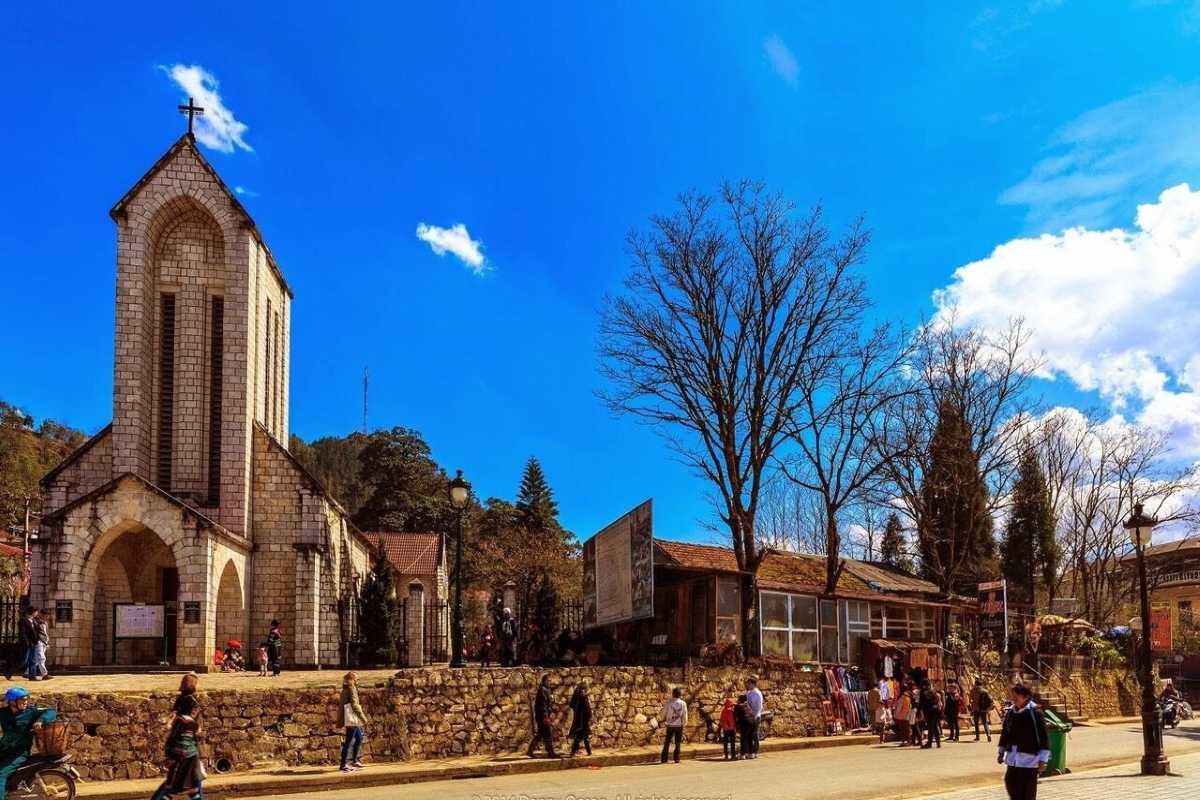
Tales and Traditions: Cultural Life Around the Stone Church Sapa
No visit to Stone Church Sapa is complete without feeling the pulse of local traditions and spiritual celebrations that unfold around its stone steps. Throughout the year, the church serves as both a spiritual anchor and a stage for some of the town’s most cherished events. For travelers seeking not just history but vibrant, living culture, this is where you’ll find music, color, and the joyful energy of community. Whether you arrive for a major holiday or stumble upon a festival by chance, you’ll discover a deep sense of belonging that welcomes you in.
Notable events and traditions rooted in the church
The calendar in Sapa is filled with special moments centered on Stone Church Sapa, drawing both locals and visitors into heartfelt celebration.
- Christmas Sapa: Every December, the church square transforms with twinkling lights, festive decorations, and midnight Mass attended by families and visitors from across the region. Caroling, nativity scenes, and a warm communal spirit fill the air.
- Easter Sapa: The Easter holiday is another highlight, with processions, music, and open-air celebrations that blend solemn ritual with joyful renewal.
- Traditional performances: Cultural evenings often feature ethnic music, dance, and song, staged right in front of the church. These performances celebrate the region’s diverse roots and are often timed with festivals or public holidays.
- Community gatherings: From market days to public ceremonies, the church square is the go-to gathering place, especially during local festivals or when important announcements are made.
For those hoping to catch these magical moments, consider timing your visit around Christmas Sapa or Easter Sapa—or ask Asia Travel Links about festival dates and the best times for cultural immersion. These events turn the Stone Church Sapa into a living symbol of celebration and connection.
Stories from Sapa’s ethnic minority communities
The real magic of Stone Church Sapa is found in the way it brings together Sapa’s vibrant ethnic tapestry. The square in front of the church isn’t just a scenic spot—it’s a crossroads where ethnic minorities Sapa such as the Hmong, Dao, and Tay interact, exchange news, and participate in age-old traditions.
A highlight for many is the legendary Love Market Sapa, held on Saturday evenings. Here, young people from surrounding villages gather not just to trade, but to flirt, sing, and play traditional games—a custom that’s both a rite of passage and a celebration of romance. During these evenings, the church is a glowing backdrop, and the whole square buzzes with music, laughter, and colorful attire. Visitors are often welcomed to watch, listen, or even join in, provided they do so respectfully.
There are countless smaller stories too: a Dao grandmother offering handmade jewelry by the steps, or a Hmong family pausing to pray before heading to the market. These moments reveal the heart of Sapa—a place where heritage and daily life blend naturally. If you’re eager to witness the spirit of the Love Market Sapa or meet local artisans, let us know at Asia Travel Links. We’ll help you find authentic ways to connect with this living, breathing culture at the heart of Stone Church Sapa.

Experience the Best Things to Do at Stone Church Sapa
The best way to connect with Stone Church Sapa is to make your visit an experience, not just a quick stop. Whether you want to dig into local history, capture the perfect photograph, or relax with local treats, this section will guide you to the most rewarding activities. With its central setting and lively Sapa atmosphere, every moment at the church offers new discoveries. Let these ideas spark your own adventure, and remember—if you need custom advice, email us at Asia Travel Links for a tailored itinerary.
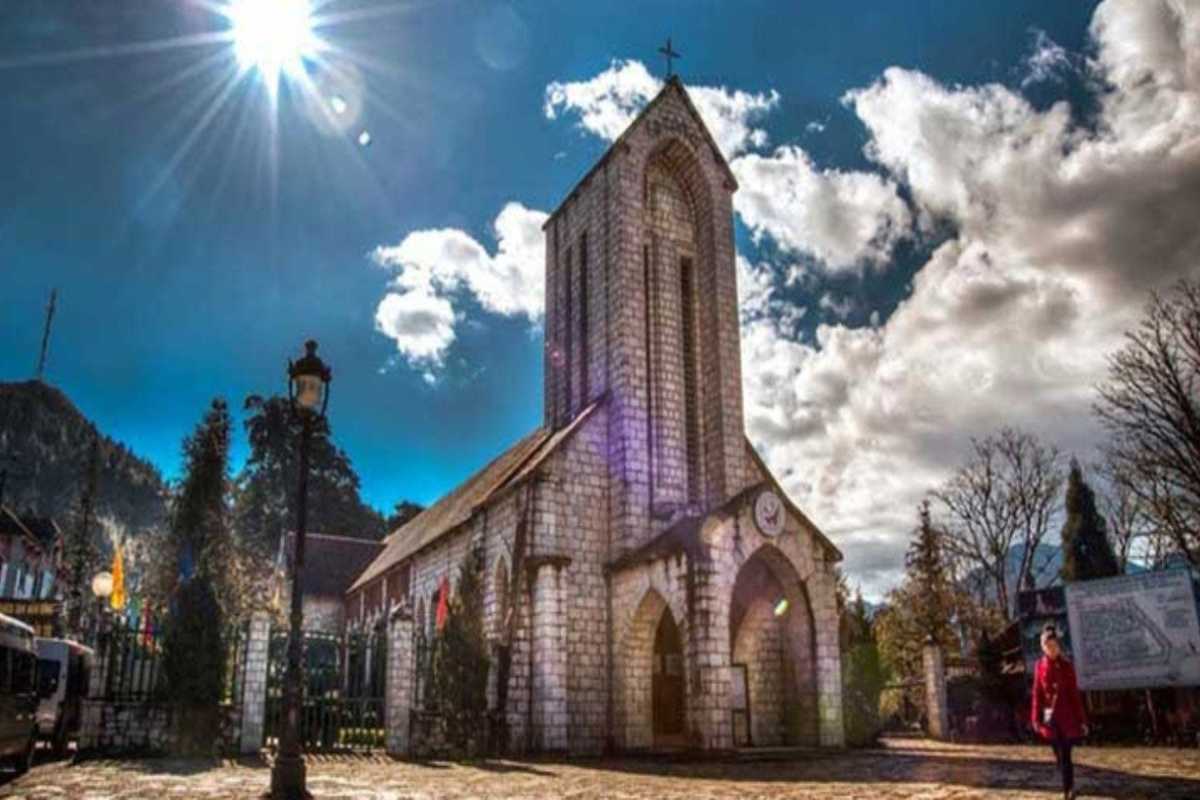
Take a Guided or Self-Guided Tour
You have plenty of options when it comes to exploring Stone Church Sapa. If you prefer in-depth stories and historical context, a guided tour Stone Church Sapa led by a knowledgeable local is the way to go. Guides share fascinating details you might otherwise miss, from legends about the church’s bell to stories of community gatherings in the church square Sapa. For independent spirits, a self-guided tour Sapa is just as rewarding. Download a map, or simply wander at your own pace, taking time to notice details and snap photos where the light hits just right.
Both approaches let you appreciate the best features and the atmosphere. The important thing is to keep your eyes open—there’s history in every stone and energy in every corner. To arrange a private tour or get the latest self-guided routes, reach out to us at Asia Travel Links for updated info and booking.
What to look for during your walk-through
No matter how you explore, don’t miss these highlights on your visit to Stone Church Sapa:
- Bell: Listen for the mellow chime marking the hour—an essential part of any guided tour Stone Church Sapa or solo wander.
- Cross: A symbol atop the main tower, visible from much of town.
- Interior altar: Step inside (when open) to see the simple yet striking altar and religious artwork.
- Stained glass: Sunlight streaming through colorful glass adds an unexpected vibrance to the stone interior.
- Building materials: Note the weathered stone and local craftsmanship used throughout.
- Church square Sapa: Take in the lively plaza, always full of street life and community.
Ticking these off your list ensures you leave with a full sense of the church’s character and history. If you’re planning a self-guided tour Sapa, ask us at Asia Travel Links for a printable checklist and insider shortcuts.
Insider tips for the best photo spots
For every traveler with a camera, Stone Church Sapa offers countless angles for that perfect shot. Here’s where to get your best images:
- From the church square: Capture the full facade with the mountains behind, especially at sunrise.
- Cafes near Stone Church Sapa: Order a coffee at a nearby cafe and shoot from their terrace for a relaxed, elevated view.
- Side street angles: Wander around the perimeter for different perspectives and less-crowded backgrounds.
- From Ham Rong Mountain: Hike up for panoramic shots that frame the church in the context of Sapa town.
- Afternoon light: For dramatic shadows and warm colors, aim for late afternoon or early evening—the golden hour never disappoints.
With these tips, you’ll come home with standout photos, no matter your gear. For the best up-to-date recommendations and local photo walks, check in with Asia Travel Links—we love helping travelers find new perspectives on Stone Church Sapa.
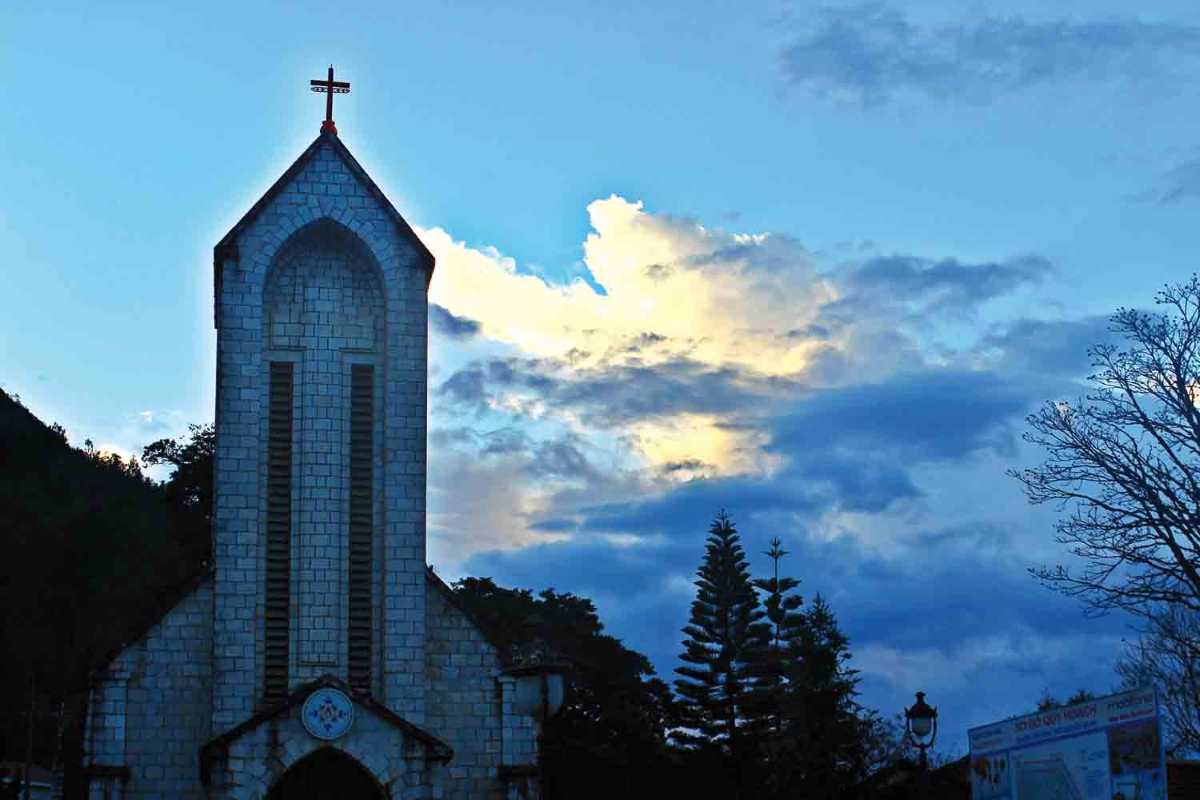
Join Local Events and Cultural Festivals
There’s no better way to experience the heart of Stone Church Sapa than by joining the many vibrant events and celebrations held here. The church square regularly fills with color, music, and laughter—offering both spiritual moments and joyful community gatherings. For visitors looking to add meaning and energy to their journey, attending these local happenings ensures memories you’ll carry home. For the latest event calendar and personal recommendations, contact us at Asia Travel Links before your trip.
Weekly Mass, special religious celebrations, and cultural shows
Whether you’re seeking a quiet moment of reflection or the lively pulse of a festival, Stone Church Sapa offers opportunities for both.
- Sunday Mass Sapa: Held every Sunday morning, Mass at the church is open to all. Services typically begin at 7:00 AM, with additional Mass times on religious holidays.
- Religious holidays Sapa: Christmas and Easter are especially grand, featuring processions, special prayers, and beautifully decorated altars. Arrive early to find a seat or stand in the square and absorb the festive atmosphere.
- Cultural shows Sapa: Throughout the year, the church square hosts traditional performances, including folk music, ethnic dance, and storytelling—often aligned with festivals or public holidays.
- Community events: Look out for local announcements, as many spontaneous celebrations or commemorations are hosted at the church, drawing in both residents and travelers.
Attending these events lets you experience firsthand the spiritual and cultural energy of the town. If you want to plan your visit around specific celebrations or performances, just email us at Asia Travel Links for up-to-date information and the best viewing tips.
How to catch the famous Sapa Love Market and other local happenings
The Love Market Sapa is a tradition unique to this region and one of the most memorable events you can witness near the church. Taking place on Saturday evenings in the square, the Love Market’s origins go back generations—it began as a way for young people from different villages to meet, court, and showcase their talents through music and dance.
To experience this iconic event, plan to arrive at the church square by early evening. You’ll see young Hmong and Dao men and women in vibrant dress, the square filled with music, laughter, and the buzz of anticipation. Be sure to observe respectfully—locals welcome curious travelers, but the market’s meaning goes beyond performance, rooted in tradition and hope.
Other local happenings Sapa include food fairs, craft stalls, and impromptu performances, especially during festival seasons. These gatherings are an ideal way to soak up authentic town spirit and discover what makes Sapa so unique.
If you’d like insider tips on attending the Love Market Sapa or want to time your trip for special events, just call us or visit Asia Travel Links for personalized advice.
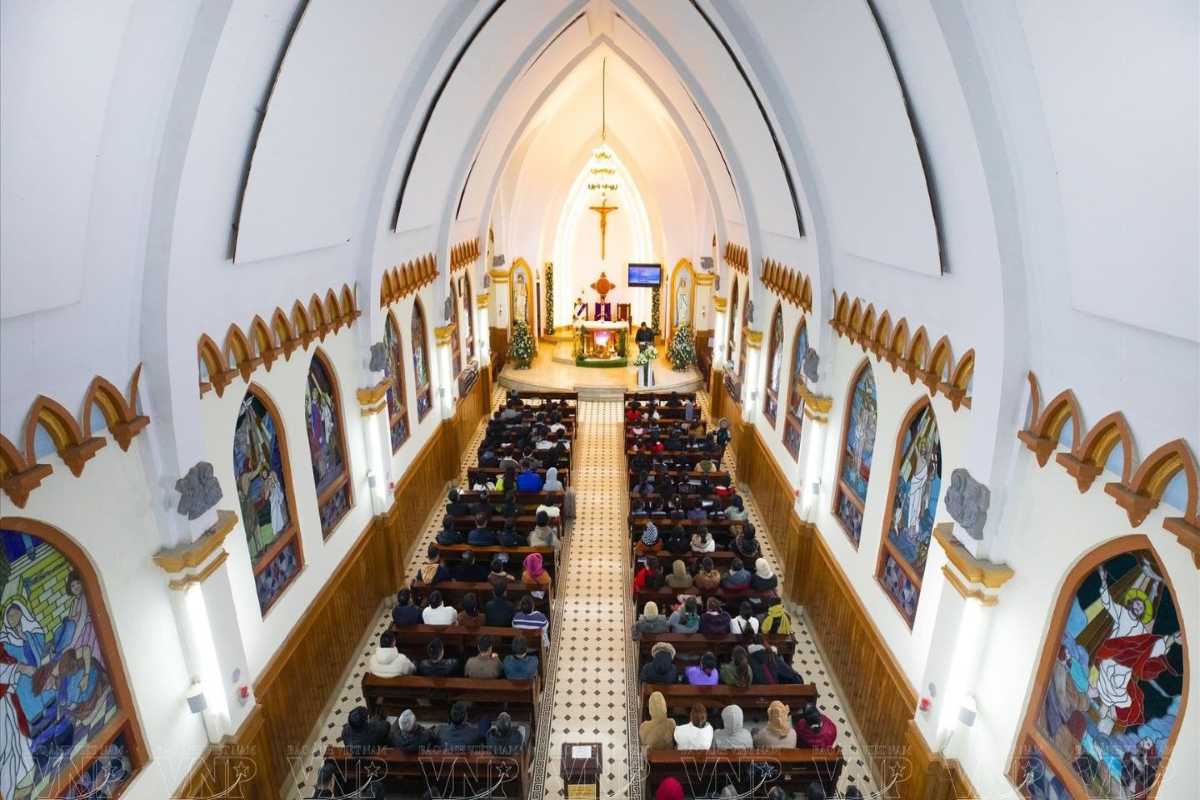
Savor the Atmosphere – Relax, Reflect, and Connect
A visit to Stone Church Sapa isn’t only about ticking off landmarks—it’s about slowing down, soaking in the atmosphere, and finding those moments of genuine connection that define travel. Here, the church square feels like the living room of Sapa—open to everyone, pulsing with life, and full of small joys waiting to be discovered. If you want to truly experience the heart of the town, spend some time here simply being present. For extra recommendations or booking help, just email us at Asia Travel Links.
Why the church square is Sapa’s living room
There’s no place quite like the church square Sapa. Throughout the day, you’ll find children playing chase around the steps, vendors chatting with friends and customers, and travelers pausing to rest or snap photos. The air is a mix of laughter, conversation, and the distant ring of the church bell. At dusk, as the sun fades, the square glows with the warm lights from nearby cafes, and the whole scene feels like a gathering of friends.
For many, the best memories are made simply by sitting on a low wall, sharing a snack, and people-watching. The square is where local news is swapped, families meet after work, and musicians might strike up a tune without warning. Whether you’re alone or with a group, the Stone Church Sapa square invites you to join in, relax, and feel part of the community.
Make time to linger, observe, and maybe strike up a conversation—you never know what stories or new friends you’ll discover. For tips on the liveliest times or quieter moments, reach out to Asia Travel Links before your visit.
Where to grab coffee, snacks, or shop for local crafts nearby
Round out your experience at Stone Church Sapa by treating yourself to a local snack or browsing the handmade goods nearby. Here are a few tried-and-true spots and tastes you shouldn’t miss:
- Cafes near Stone Church Sapa: Try Cong Cafe or Le Gecko for great coffee, fresh pastries, and window seats with perfect church views.
- Local crafts Sapa: Step into the small shops lining the square—look for embroidered bags, indigo textiles, and silver jewelry crafted by Hmong and Dao artisans.
- Food stalls: Sample grilled eggs Sapa or freshly roasted corn Sapa from vendors at the church entrance, perfect for a quick bite on a chilly day.
- Market treats: Head to Sapa Market for even more snacks and unique souvenirs, all within a short stroll of the church.
- Casual dining: Enjoy a relaxed lunch at The Hill Station or Little Sapa, both popular with locals and visitors.
With so many options just steps away, you’ll find it easy to relax, refuel, and bring a piece of Sapa home with you. For up-to-date recommendations on where to eat, drink, or shop, message us at Asia Travel Links and we’ll send you our personal favorites.
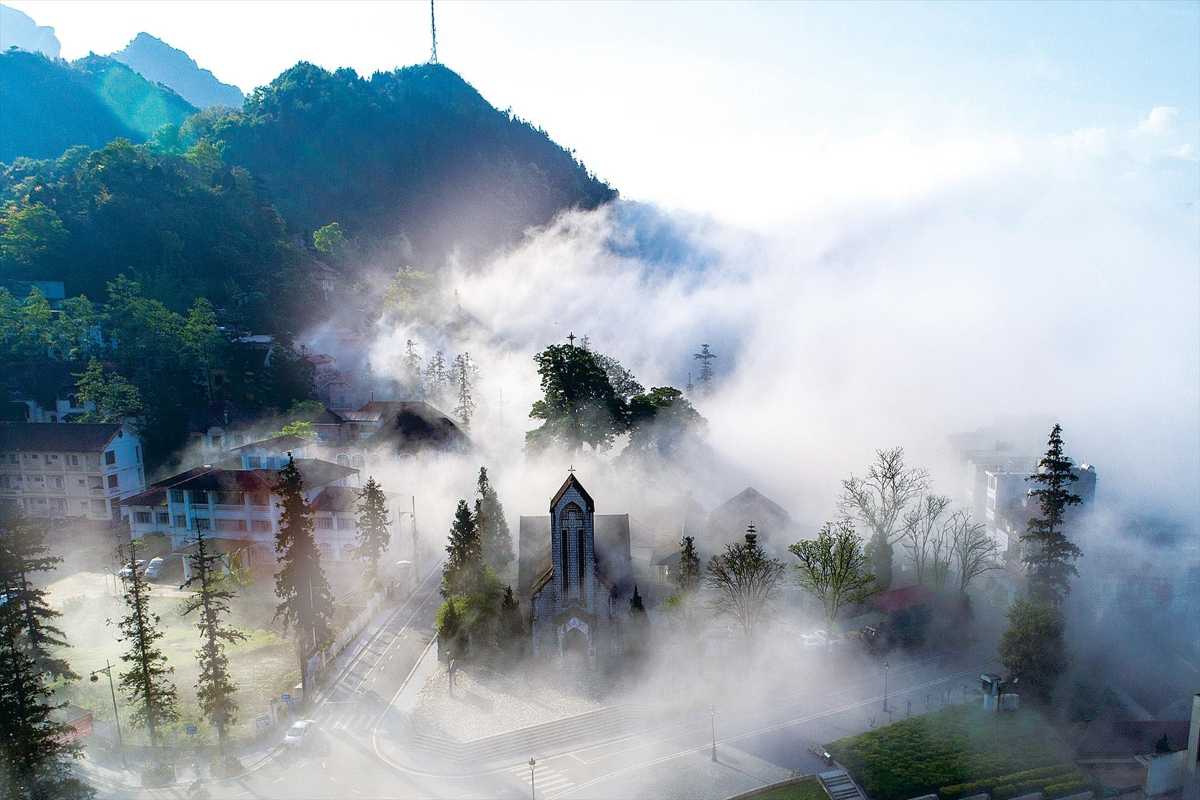
Planning Your Perfect Visit to Stone Church Sapa
Making the most of your trip to Stone Church Sapa starts with a little smart planning. From picking the right season to packing the right shoes, every detail shapes your experience in Sapa. With its shifting weather, lively town center, and array of travel options, being prepared means more time soaking up the sights and less time worrying about logistics. This section covers everything you need for a smooth, memorable adventure—so you can focus on discovery, not details. For a customized itinerary or booking support, just email us at Asia Travel Links.
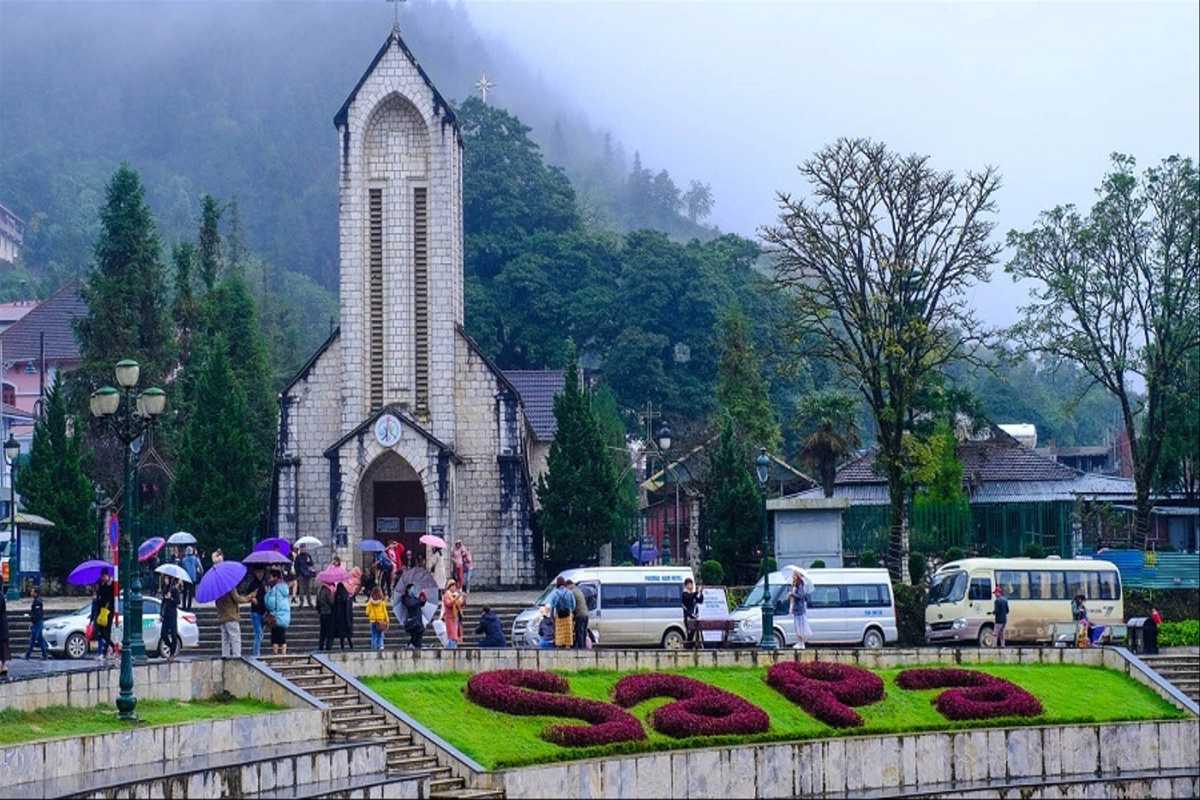
Best Time to Visit: Seasons, Crowds & Events
If you’re wondering about the best time to visit Stone Church Sapa, it all comes down to what kind of atmosphere you prefer. Each season in Sapa brings a unique vibe to the church, changing the light, the crowds, and the whole feel of your trip.
- Spring (March–May): Expect fresh air, blooming flowers, and comfortable temperatures. This is a popular time for photographers, with fewer crowds Stone Church Sapa compared to summer.
- Summer (June–August): Warm and lively, with lush landscapes and more visitors—especially during school holidays. Expect busy squares and plenty of activity, but be ready for the occasional rain shower.
- Autumn (September–November): Clear skies, golden rice terraces, and a gentle chill in the air. This is often considered the best time to visit Stone Church Sapa, thanks to perfect walking weather and great visibility.
- Winter (December–February): Chilly, misty, and sometimes magical. You’ll find the fewest crowds Stone Church Sapa, especially early in the morning. Winter is perfect for atmospheric photos, but bundle up for cold snaps and possible fog.
Each season offers something special, whether it’s festive events in winter or postcard scenery in autumn. If you want to avoid the largest crowds and enjoy ideal walking weather, plan for the shoulder months. To align your trip with a festival or holiday, ask us at Asia Travel Links about the latest event schedule and crowd forecasts for Stone Church Sapa.
Linh's Misty Morning Moment: Photographing the Church in Winter
Most travel guides will tell you Sapa shines brightest under the summer sun or during the golden harvest of autumn, but my recent trip unveiled a completely different, almost mystical side of the Stone Church that I believe is unparalleled. It wasn't just another photo session; it was an exercise in patience and a dance with the elements, resulting in some of the most ethereal and deeply personal photographs I've ever captured.
Stepping out of my guesthouse before dawn, a shiver ran down my spine, a crisp greeting from Sapa's winter air. The town was still largely asleep, a blanket of thick, damp mist clinging to every surface, muffling sounds, and transforming familiar streets into a mysterious, muted landscape. My breath plumed out in front of me with every excited exhale. My hands, despite gloves, felt the immediate bite of the cold. My expectation was simple: to capture the iconic Stone Church. My reality was a swirling, opaque canvas, challenging me to find beauty in its elusive veil.
I made my way to the square, guided more by instinct and the faint glow of streetlights than by sight. The usual bustling square was utterly silent, save for the distant crow of a rooster and the soft drip of condensation from eaves. It felt like stepping into a forgotten dream. The Stone Church, typically a dominant landmark, was a mere silhouette, its Gothic spires dissolving into the swirling white. A wave of initial disappointment washed over me – how could I photograph what I could barely see? But then, a quiet curiosity settled in. This wasn't a challenge to overcome, but an invitation to feel the place, to experience its quiet power.
I set up my tripod, wiping condensation from my lens every few minutes, my fingers growing numb. The process unfolded slowly, deliberately. I’d wait, watching as the mist would momentarily thin, revealing a hint of the bell tower, a brief outline of an arched window, only to swallow it whole again. It was like watching a slow, silent reveal, and each fleeting glimpse felt like a secret shared just with me. The air was thick with the scent of damp earth and distant woodsmoke, a grounding presence amidst the ethereal fog. There was a unique tranquility to it, a profound sense of peace that you simply don't find in the bustling high season. My excitement wasn't loud or boisterous; it was a quiet thrill, a deep satisfaction in witnessing something so uniquely beautiful. I found myself focusing on smaller details – the texture of the moss on the stone, the faint glow of the cross when the light managed to pierce through, the intricate patterns of the fog itself. Each shot felt like a meditation, a capture of the church’s enduring spirit through its veil.
What I learned that morning was that "perfect" visibility isn't always "perfect" photography. The mist wasn't an obstacle; it was the subject, transforming the church into a poetic, atmospheric masterpiece. It demonstrated the true resilience of the structure, standing strong and beautiful even when shrouded. My expertise was honed not by perfect conditions, but by adapting to challenging ones, seeking beauty in the unexpected. The authenticity of the moment, the cold on my cheeks, the dampness in the air, made every click of the shutter more meaningful.
Actionable Practical Takeaways for Your Winter Church Photography:
- Dress Warmly, and Then Some: Layers are key. Think thermal base layers, a fleece, a waterproof/windproof outer shell, warm socks, and waterproof boots. Don't forget a warm hat and thick, touchscreen-friendly gloves.
- Protect Your Gear: Mist means moisture. Bring lens cloths, silica gel packets for your camera bag, and consider a rain cover for your camera, even if it's just a plastic bag.
- Extra Batteries are Non-Negotiable: Cold temperatures drain batteries much faster. Keep spare batteries in an inside pocket to keep them warm.
- Embrace the Atmosphere: Don't fight the mist. Use it to your advantage to create moody, ethereal shots. Look for silhouettes, diffused light, and details that emerge from the fog.
- Go Early: Early mornings offer the best chance for quiet, undisturbed mist. Plus, watching the fog dissipate (or thicken!) as the town wakes up is an experience in itself.
- Patience is a Virtue: You might need to wait for moments when the mist clears slightly or shifts to reveal more of the church.
- Look for Light: Even on misty days, the sun might peek through briefly. These moments create incredible beams of light and dramatic shadows.
My misty morning with the Stone Church Sapa wasn't just a photography session; it was a profound connection with the quiet soul of Sapa. It taught me that the most memorable experiences often lie beyond the conventional, requiring a little bravery and an open mind to the unexpected. The photographs I brought home weren't just images; they were tangible memories of a truly unique encounter.
Recommendation:
If you're seeking a genuinely unique and unforgettable experience in Sapa, I wholeheartedly recommend visiting the Stone Church during the cooler, misty months. It offers a completely different, almost spiritual, perspective that no sunny day can replicate. Go prepared, go early, and let the magic of the Sapa mist envelop you and this timeless landmark.
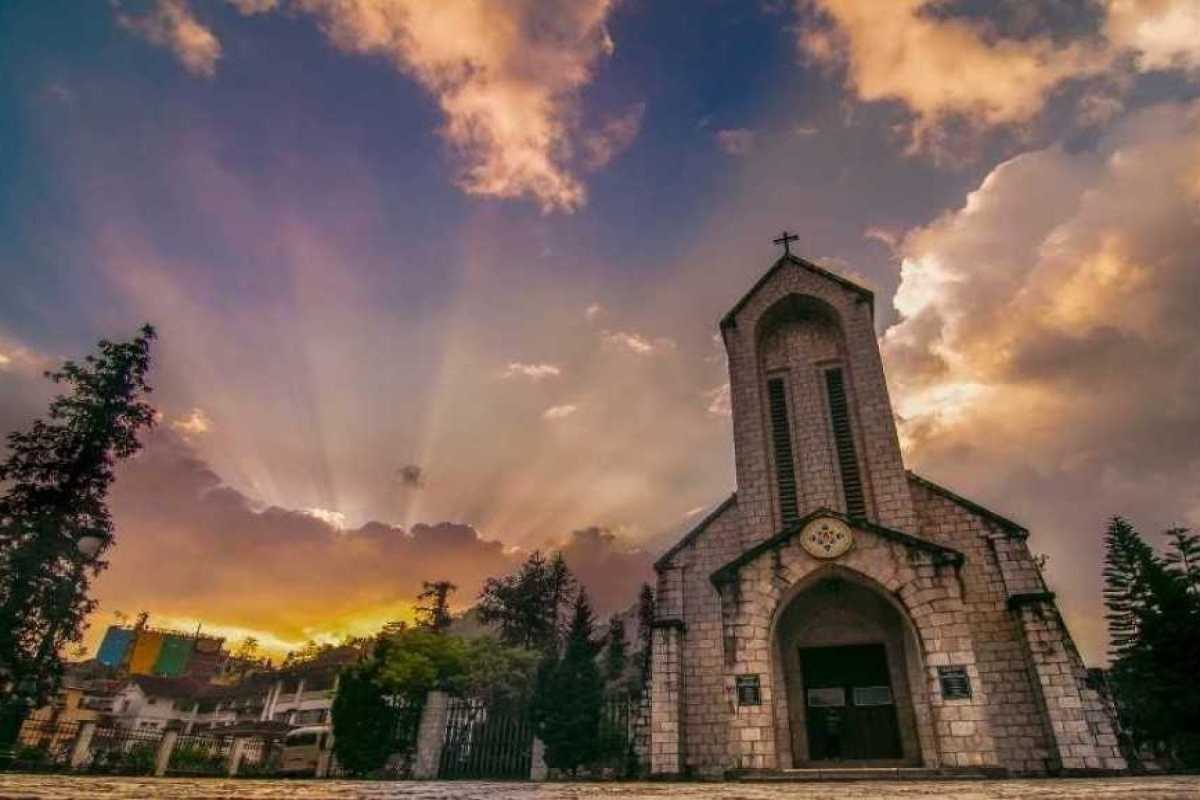
Getting There: Your Gateway to the Church
Reaching Stone Church Sapa couldn’t be easier, thanks to its location right in the heart of Sapa. Whether you’re based in a hotel nearby, arriving from the bus station, or exploring from another corner of town, you’ll have plenty of options to choose from.
If you’re staying in central Sapa, the most pleasant way is walking to Stone Church Sapa. Most major hotels and homestays are within a 5–15 minute stroll, and the path takes you through lively markets, winding streets, and scenic viewpoints. Simply follow signs to Sapa Square or ask a local to point the way on your Sapa map. It’s a gentle, uphill walk but accessible for most travelers.
Prefer wheels? Grab a taxi to Stone Church Sapa from anywhere in Sapa—fares are reasonable, and drivers know the landmark by name. If you’re feeling adventurous, rent a motorbike Sapa for the day; the ride is quick, fun, and lets you explore surrounding attractions at your own pace. There’s easy parking just steps from the church.
No matter how you choose to arrive, the last approach offers a sense of anticipation as the stone spire comes into view and the sounds of the square grow louder. For turn-by-turn directions, a printable Sapa map, or help arranging a transfer, just email us at Asia Travel Links. We’ll make sure your arrival at Stone Church Sapa is as smooth as the journey itself.
Marco's Motorbike Adventure: Finding the Church on Two Wheels
While many visitors opt for taxis or leisurely strolls, my Sapa adventure truly kicked into high gear the moment I swung my leg over a rented motorbike. There's a raw, exhilarating freedom to exploring Sapa on two wheels that's hard to beat, and finding the iconic Stone Church this way wasn't just about reaching a destination; it was about the journey itself – a winding, sensory-rich dance through the heart of the town. This wasn't just efficient travel; it was an intimate engagement with Sapa's vibrant pulse.
My day began with the familiar rumble of the small scooter coming to life beneath me. The cool Sapa air, tinged with the scent of pine and exhaust fumes, brushed against my face as I navigated out of the quieter backstreets near my homestay. My excitement was palpable, a mix of the thrill of the open road (even if it was a town road!) and the slight apprehension of navigating unfamiliar territory. The sounds of Sapa — the chirping of crickets, the distant murmur of vendors, and the occasional honk of a passing vehicle — all merged into a lively symphony.
The journey to the Stone Church, perched right in the town's bustling center, was a microcosm of Sapa's charming chaos. Initially, the streets were narrow and winding, dotted with small shops and guesthouses. I found myself slowing down, weaving gently past street-side stalls overflowing with colorful textiles and local produce, the aroma of grilled meats occasionally wafting past. The first challenge came in the form of occasional, unexpected traffic – a cluster of motorbikes, a passing mini-van, or even a few cows ambling across the road. It required quick reflexes and a gentle hand on the throttle, but the key was to move with the flow, not against it. Locals on their bikes seemed to effortlessly glide, and I quickly adapted to their patient, intuitive rhythm. The vibrant kaleidoscope of life unfolded around me: children playing by the roadside, women from ethnic minority groups chatting, their traditional attire a splash of vivid color against the muted tones of the buildings.
As I approached the town center, the roads widened slightly, and the energy intensified. The constant gentle hum of my engine felt like a natural part of the town’s soundtrack. Suddenly, through a gap in the buildings, I caught my first clear glimpse of the Stone Church's grey stone spires piercing through the morning haze. It stood grand and resolute, a beacon drawing me in. The ease of parking once I reached the main square was a pleasant surprise; dedicated motorbike parking areas were plentiful, making it incredibly convenient to simply pull up, park, and step right into the heart of Sapa. The exhilaration of the ride was immediately replaced by a sense of calm awe as I stood before the architectural marvel, knowing I had navigated Sapa’s delightful intricacies entirely on my own terms.
The personal resonance was immense. This wasn't just a church I visited; it was a landmark I'd reached through my own adventurous spirit. The small challenges along the way only amplified the satisfaction of arriving. It proved that exploring Sapa on a motorbike is not just feasible, but genuinely enhances the immersive experience. My "expertise" was born from navigating those very streets, understanding the flow, and finding the sweet spots for parking.
Actionable Practical Takeaways for Your Motorbike Trip to Stone Church Sapa:
- Rent from a Reputable Shop: Ask your hotel or guesthouse for recommendations. Ensure the bike is in good condition, and always wear a helmet (often provided with the rental). Check the brakes and lights before you leave.
- Don't Fear the Traffic, Flow With It: Sapa's traffic is rarely aggressive. It's more of a continuous, fluid movement. Avoid sudden stops or sharp turns. Be predictable.
- Google Maps is Your Friend (Mostly): Download offline maps for Sapa as cell service can be spotty outside the main town. The Stone Church is clearly marked as a central landmark.
- Parking is Easy: There are designated motorbike parking areas around Sapa Square, often manned by attendants who will guide you. Fees are usually very minimal (e.g., 5,000-10,000 VND).
- Go Slow in Busy Areas: Especially around the main square and market, reduce your speed. Pedestrians can be unpredictable.
- Watch for Potholes and Uneven Roads: While generally good, some smaller side streets can have rough patches, especially after rain.
- Carry Small Denominations: Handy for parking fees or quick stops for drinks.
My motorbike journey to the Stone Church was more than just a commute; it was an integral part of my Sapa story. It connected me to the town in a way that walking or taking a taxi simply couldn't, giving me the freedom to stop, observe, and truly absorb the local rhythm.
Recommendation:
If you're an adventurous traveler with some experience on two wheels, I wholeheartedly recommend renting a motorbike to visit the Stone Church Sapa and explore the surrounding town. It offers unparalleled freedom, convenience, and a truly authentic, exhilarating way to experience the heart of Sapa. Just remember to ride safely and embrace the journey!
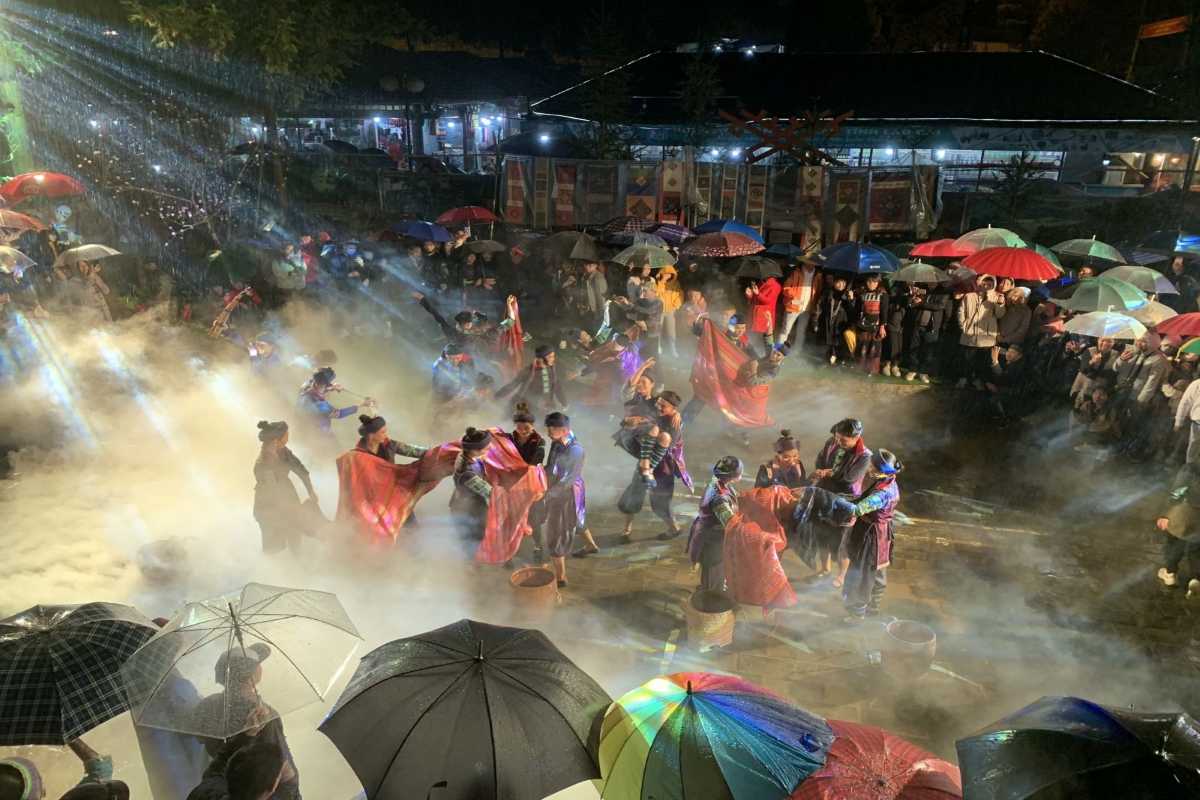
Essential Packing List for a Church Visit & Beyond
For a smooth, enjoyable trip to Stone Church Sapa, being prepared is key. The region’s weather can change quickly, and the pace of town life means you’ll want to carry the right gear for every moment—from peaceful walks to photo opportunities. Here’s a practical packing list Sapa visitors can rely on:
- Layers: Sapa’s temperatures can swing from warm afternoons to chilly evenings, so pack at least one light jacket and a warm sweater.
- Comfortable walking shoes Sapa: You’ll do plenty of strolling, sometimes on uneven stone paths or steep hills. Good shoes make all the difference.
- Rain gear Sapa: Showers pop up year-round, especially in summer. A compact rain jacket or small umbrella keeps you dry without adding bulk.
- Camera essentials Sapa: Don’t forget your camera or smartphone for all those stunning photos. Bring extra memory cards and a lens wipe, especially during misty mornings.
- Power bank Sapa: Outlets can be scarce, especially if you’re out all day. A portable charger keeps your devices ready for every photo op.
- Small backpack: Perfect for carrying snacks, water, and anything you buy along the way.
- Sunscreen and hat: Even on cloudy days, UV rays can be strong in the mountains. Protect your skin and eyes.
Packing thoughtfully means you can focus on exploring Stone Church Sapa and soaking up every moment. For a custom, trip-specific list or tips based on your travel dates, reach out to Asia Travel Links—we’re happy to help you pack with confidence.
Sarah's Savvy Sapa Kit: From Rain Gear to Camera Essentials
I’ve learned the hard way that packing smart can make or break a travel experience, especially in a place as wonderfully unpredictable as Sapa. Before my trip to the Stone Church, I meticulously prepared a kit, and honestly, every single item proved its worth. This wasn't just about having stuff; it was about having the right stuff that genuinely enhanced my comfort, allowed me to capture incredible moments, and navigate Sapa's unique climate with confidence. It's the difference between merely visiting and truly experiencing the destination.
My journey to Sapa was driven by a desire to fully immerse myself in its culture and capture its breathtaking landscapes, including the majestic Stone Church. I had heard tales of Sapa's capricious weather – sunshine one minute, a sudden downpour the next, followed by a mysterious mist rolling in. This knowledge became the cornerstone of my packing philosophy. My backpack felt a little heavier than usual, but it was a weight of preparedness, not burden.
The morning I planned to spend at the Stone Church dawned bright, but with a lingering promise of clouds. I set out with my compact camera, eager to capture the morning light on the ancient stones. As I explored the intricate architecture and absorbed the peaceful atmosphere of the church square, the sky began to darken almost imperceptibly. Suddenly, a light drizzle started, quickly escalating into a proper Sapa shower. This is where my foldable, lightweight rain jacket truly became my hero. I pulled it out of my daypack in seconds, and it saved me from being completely soaked. While others around me scrambled for cover or bought flimsy ponchos, I was able to continue my exploration, even snapping a few atmospheric photos of the church under a soft rain, its stone facade glistening. Without it, I would have been forced to cut my visit short and seek shelter, missing those unique, misty moments.
Later that afternoon, after exploring the church and grabbing a coffee nearby, I reviewed my photos. I realized I had taken far more shots than anticipated – every angle of the church, the bustling square, the vibrant market stalls, and countless candid moments of local life. My camera battery, which I thought would last all day, was dangerously low. This is where my trusty portable power bank stepped in as my unsung hero. I plugged in my camera, and within minutes, it was re-energized, allowing me to continue my photography spree without missing a beat. It wasn't just convenient; it was crucial for capturing the essence of Sapa without worrying about power outlets or dead batteries. I also found my comfortable, waterproof walking shoes invaluable. Between navigating the sometimes uneven cobblestones around the church square and an impromptu stroll through a nearby village, my feet remained dry and blister-free, which truly made all the difference in my overall comfort and ability to keep exploring.
These weren't just random items; they were deliberate choices based on Sapa's reputation, and they paid off exponentially. My personal experience confirmed that preparing for the unexpected, especially with the right gear, transforms potential challenges into opportunities for deeper engagement and discovery. It gave me the confidence to wander freely, knowing I was ready for whatever Sapa threw my way.
Actionable Practical Takeaways for Your Savvy Sapa Kit:
- The Indispensable Rain Jacket: Choose one that's lightweight, waterproof, and easily packable. Even in the dry season, Sapa can surprise you with quick showers. It's your shield against unexpected downpours.
- A Robust Portable Power Bank: Your phone and camera will work overtime capturing Sapa's beauty. A high-capacity power bank ensures you never miss a shot and can stay connected.
- Comfortable, Waterproof Walking Shoes: You'll be doing a lot of walking on various terrains – from town streets to potentially muddy paths. Prioritize comfort and water resistance to keep your feet happy.
- Layer Up, Always: Sapa's temperature can fluctuate wildly throughout the day. Pack thin, breathable layers you can easily add or remove. Think a t-shirt, a fleece, and your rain jacket.
- Camera Protection (Beyond the Bag): Consider a small, waterproof cover for your camera, or even just a thick plastic bag, for those misty or rainy moments when you still want to shoot.
- Snacks and Water Bottle: While there are vendors, having your own reusable water bottle and some energy bars is smart for longer explorations.
- Small Backpack/Daypack: Essential for carrying all these goodies, plus any souvenirs you might pick up!
My savvy Sapa kit didn't just equip me; it empowered me to fully embrace every moment of my visit to the Stone Church and beyond. It allowed me to focus on the magic unfolding around me, rather than being distracted by discomfort or technical woes.
Recommendation:
Don't underestimate Sapa's climate. Investing a little thought into your packing list, especially focusing on rain gear and camera essentials, will significantly enhance your visit to the Stone Church and any other adventures you undertake. Trust me, it's worth it for the comfort, the memories, and those perfectly captured shots!
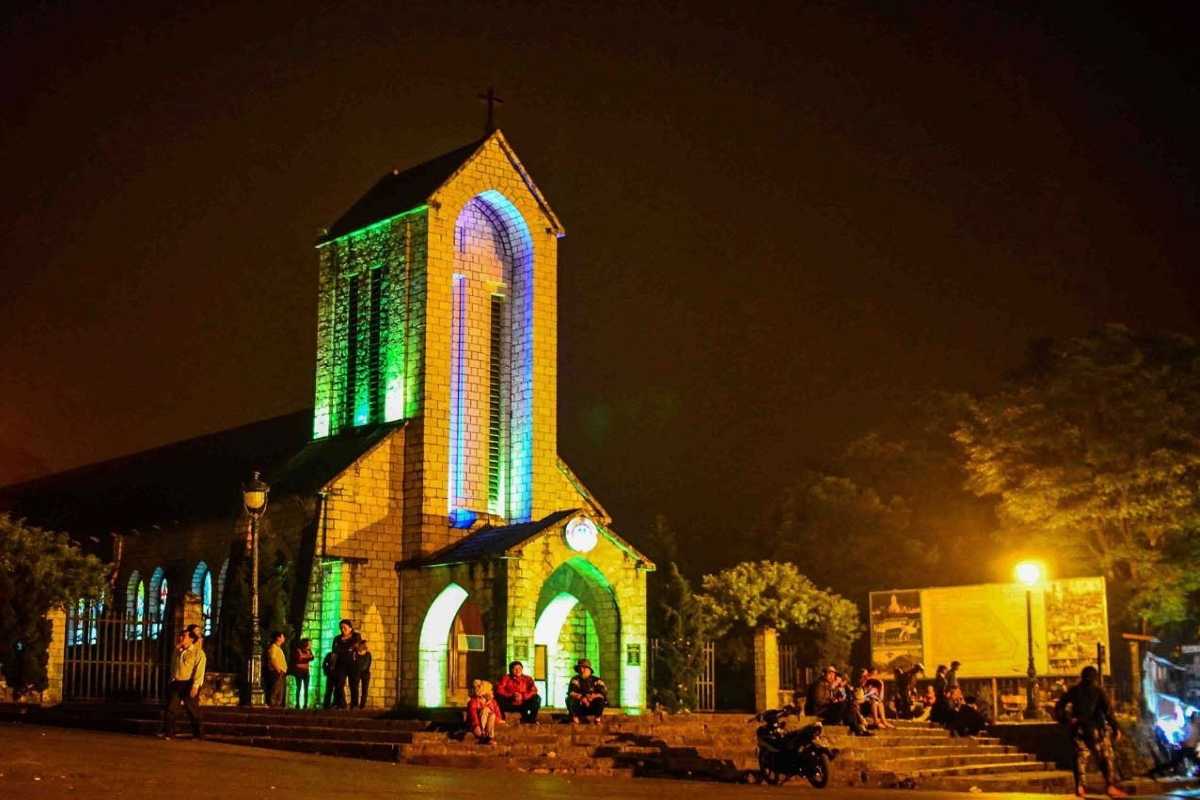
Beyond the Stones: Engaging with Local Culture Around Stone Church Sapa
Visiting Stone Church Sapa is much more than admiring its beautiful architecture—it's your gateway to the true heart of Sapa. Here, history blends seamlessly with everyday life. The area around the church pulses with the sights, sounds, and traditions of a thriving community, inviting you to connect deeply with local culture, discover authentic crafts, and experience the social energy that defines this mountain town. For travelers eager to go beyond sightseeing and make real memories, this is where Sapa’s magic comes alive. For tips on connecting with local life or arranging authentic experiences, reach out to us at Asia Travel Links anytime.
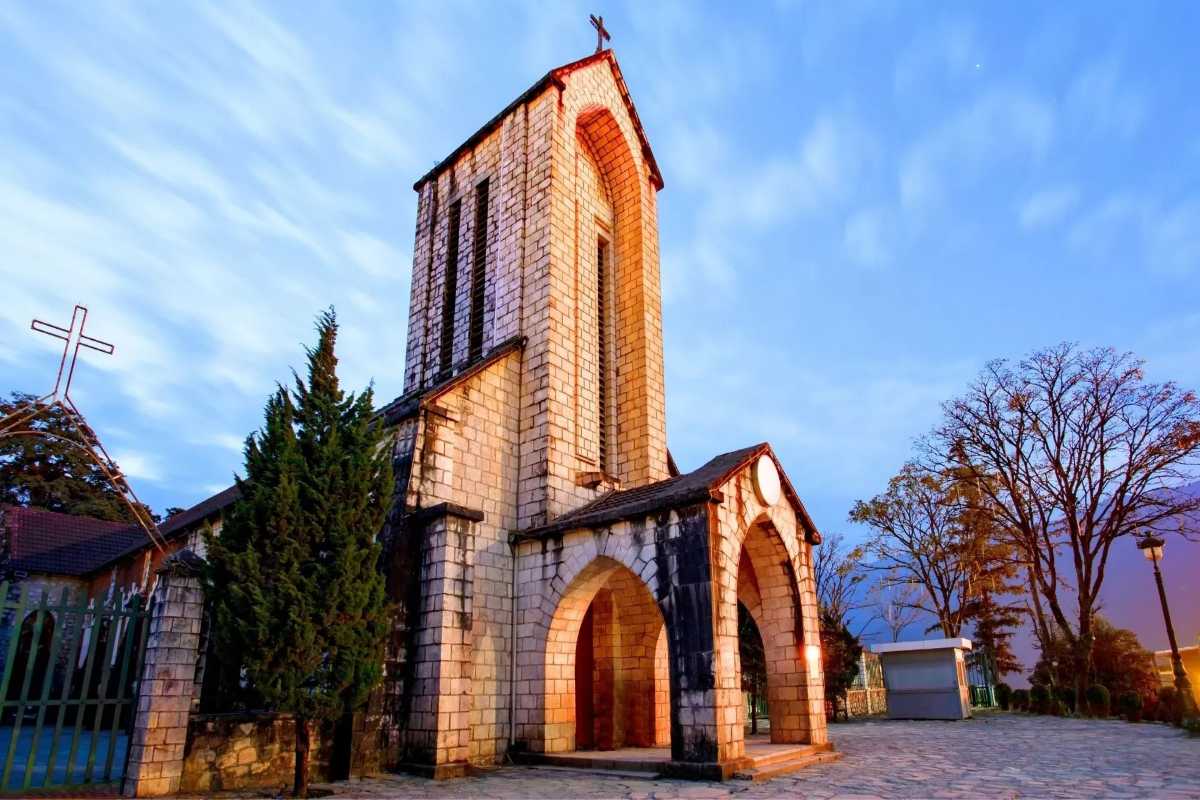
The Church as a Community Hub: Markets & Gatherings
Step into the square around Stone Church Sapa and you’ll find yourself at the very center of Sapa’s daily rhythm—a true community hub Sapa. Vendors line the edges, selling everything from fresh fruit and hot tea to handmade crafts. The air is filled with conversation as locals swap stories, share laughs, and greet neighbors. It’s a place where visitors and residents naturally mingle, offering a genuine glimpse into daily life.
At the Sapa market, which spills onto the church’s doorstep especially on weekends, you’ll meet Hmong, Dao, and Tay families offering vibrant textiles, intricate silver jewelry, and mountain-grown produce. Children dart between stalls, and elders gather on benches to watch the passing scene. The church square isn’t just a tourist spot; it’s a living crossroads for local vendors Sapa and for the community’s social interactions Sapa.
Respectful engagement Sapa goes a long way. Smile, greet vendors, and ask before taking photos—these small gestures help foster positive connections and ensure your experience is memorable for all the right reasons. When you purchase from the Sapa market, you’re supporting families who have shaped the region’s traditions for generations.
Spending time here, you’ll quickly see why the church remains at the heart of community life. For the best times to visit, what markets to explore, or dos and don’ts for responsible interaction, just email us at Asia Travel Links. We’re always ready to help you engage with Stone Church Sapa in the most rewarding ways.
David's Discovery: Witnessing the Sunday Market Energy
I'd read about Sapa's vibrant markets, but nothing, absolutely nothing, prepared me for the sensory explosion that was the Sunday Market unfolding around the Stone Church. This wasn't just a place to buy things; it was a pulsating heart, a grand stage where Sapa's diverse communities converged, a spectacle of sights, sounds, and smells that utterly captivated me from the moment I stepped into its orbit. It wasn't just an observation; it was an immersion into the very soul of the town.
The air, usually crisp and clear in Sapa, was thick with a thousand different notes: the sweet, earthy aroma of fresh produce, the smoky tang of grilled corn on the cob, the subtle perfume of indigo-dyed fabrics, and an underlying scent of damp earth. My ears were bombarded, delightfully so, by a symphony of human activity. The melodic, almost sing-song chatter of ethnic minority women, their voices rising and falling in rapid, unidentifiable languages, mingled with the occasional honk of a scooter, the distant crow of a rooster, and the laughter of children darting through the crowds. Above it all, a constant hum of commerce and camaraderie, a living, breathing soundscape.
My eyes, however, were truly overwhelmed. The Stone Church, typically the stately focal point of the square, became a magnificent backdrop to a human tapestry of unbelievable color and texture. Hmong women, instantly recognizable by their intricately embroidered jackets and headscarves, sat beside Dao women in their striking red-fringed turbans. They displayed their wares on blankets spread across the cobblestones: vibrant hand-woven textiles, intricate silver jewelry, bundles of dried herbs, and baskets overflowing with fresh, dew-kissed vegetables. I found myself drawn to a woman meticulously stitching an indigo pattern onto a piece of cloth. Despite the language barrier, her warm smile and the gesture she made for me to observe her work spoke volumes. I watched her nimble fingers, the threads moving with practiced grace, and purchased a small, beautifully crafted bracelet from her, feeling a direct connection to her skill and artistry.
Further into the throng, I encountered a group of men gathered around a bubbling pot, the rich, savory smell of thang co (a traditional Sapa hotpot) wafting through the air. One of them, seeing my curious gaze, offered me a small bowl with a friendly grin. It was an unexpected gesture, a taste of authentic Sapa hospitality that truly resonated. The energy was infectious – a constant ebb and flow of people, negotiating, laughing, sharing stories, and simply being together. It was a tangible demonstration of community, a place where people from remote villages came not just to trade, but to connect. The Stone Church, for that day, wasn't just a building; it was the silent witness to this incredible human exchange.
The feeling was one of profound fascination and joy. It wasn't just observing; it was being part of something truly special and authentic. The sheer vibrancy of the market and the genuine warmth of the interactions made it an unforgettable highlight of my trip. It was a clear demonstration of how the Stone Church acts as a true "community hub" for Sapa.
Actionable Practical Takeaways for Experiencing the Sunday Market:
- Go Early (But Not Too Early): The market usually kicks off in full swing by mid-morning. Arriving around 9-10 AM gives you time to see it develop without it being overwhelmingly crowded.
- Bring Small Bills (VND): Many vendors prefer cash, and having smaller denominations makes transactions smoother.
- Engage Respectfully: A smile goes a long way. If you want to take a photo of someone, always ask permission first. A simple gesture is usually understood.
- Bargain Gently: Bargaining is expected, but do so with a friendly demeanor. It's part of the experience, not a confrontational act.
- Be Prepared for Crowds: It gets busy, especially around lunchtime. Keep an eye on your belongings.
- Sample Local Delicacies: Don't be shy! Try the street food, from grilled eggs to steamed rice cakes. It’s fresh and adds to the experience.
- Look Beyond the Souvenirs: While there are plenty of crafts, also observe the genuine exchange of goods among locals – that's where the real magic lies.
My time at the Sapa Sunday Market around the Stone Church wasn't just a visit; it was an education in local life, a feast for the senses, and a heartwarming reminder of the power of human connection. It's an absolute must-do for anyone visiting Sapa.
Recommendation:
If your Sapa itinerary allows, absolutely plan your visit to the Stone Church on a Sunday to experience the incredible energy of the Sunday Market. It’s an unparalleled opportunity to witness Sapa’s vibrant culture and community firsthand. Don't just walk through; immerse yourself in the sights, sounds, and interactions. It's a memory you won't soon forget!
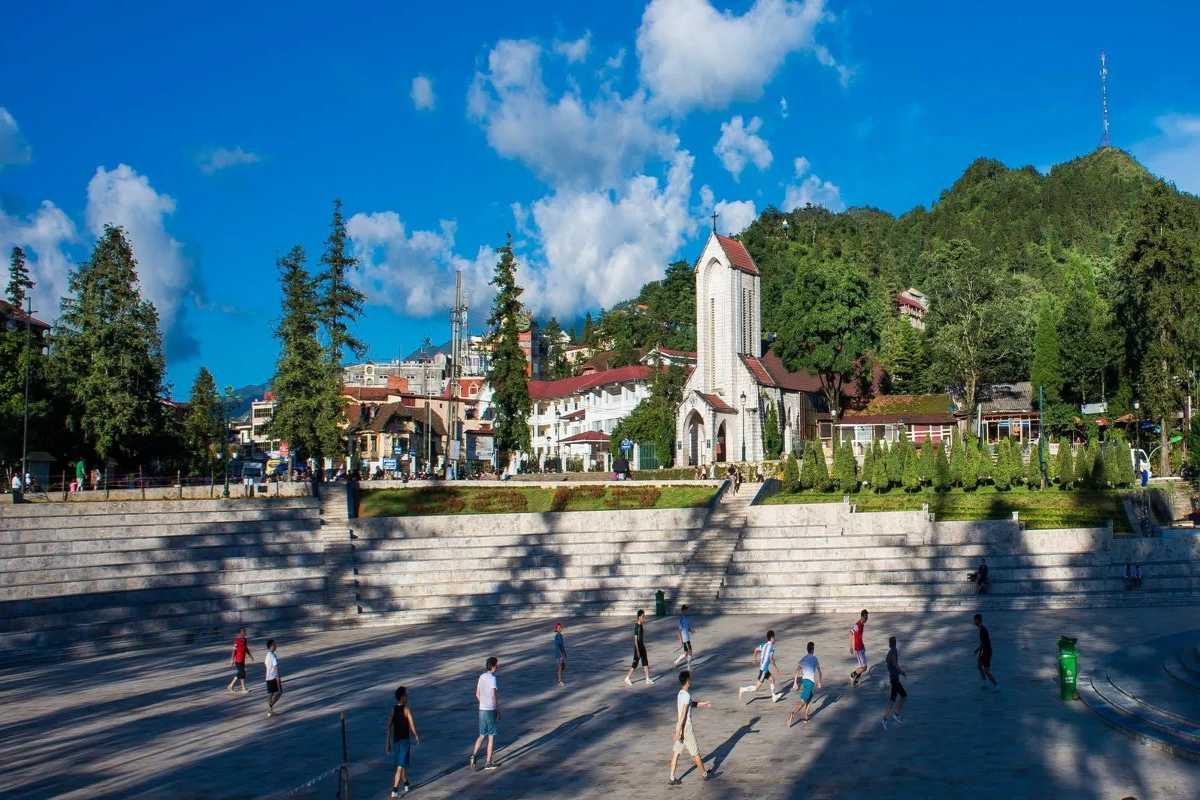
Supporting Local Artisans & Businesses Near the Church
When you shop around Stone Church Sapa, you’re not just buying souvenirs—you’re supporting the families and traditions that make Sapa unique. The town is known for its vibrant local artisans Sapa who pour generations of skill and culture into every piece they create. For travelers who value authenticity and want their purchases to make a positive impact, here’s how to do it right:
- Indigo textiles Sapa: Look for stunning hand-dyed fabrics in rich blues and purples, often crafted by Hmong women. You’ll find them as scarves, bags, or wall hangings at market stalls and small shops near the church.
- Silver jewelry Sapa: The region’s silversmiths are renowned for their intricate rings, earrings, and bracelets—each piece tells a story and often uses traditional motifs.
- Crafts Sapa: Beyond textiles and jewelry, explore embroidered pouches, bamboo goods, and hand-carved ornaments. Many vendors are happy to share how their items are made.
- Ethical bargaining Sapa: Bargaining is part of local culture, but keep it friendly and respectful. Aim to pay a fair price that honors the artisan’s work and supports their livelihood.
- Buy directly from artisans: Whenever possible, purchase from the person who made the craft—ask questions, listen to their story, and let your souvenir become a memory of real connection.
Shopping with intention brings deeper meaning to your visit. Not only will you go home with beautiful, lasting mementos, but you’ll also help sustain the creativity and heritage of Sapa’s people. For personalized recommendations on the best shops or to learn more about local crafts, email us at Asia Travel Links—we’re passionate about helping you shop responsibly at Stone Church Sapa.
Emily's Ethical Buys: Finding Hand-Woven Textiles Near the Church
My Sapa trip was about more than just sightseeing; it was about connecting with the heart of the culture. While the Stone Church itself was a magnificent landmark, it was the vibrant human activity in its immediate vicinity that truly drew me in. I’d always tried to make conscious choices when traveling, ensuring my spending genuinely supported local communities. My search for meaningful souvenirs led me to an experience near the Stone Church that solidified this philosophy: finding exquisite hand-woven textiles and, more importantly, the incredible women who created them. This wasn't just shopping; it was a deeply personal exchange, a tangible piece of Sapa's soul to take home.
After admiring the Stone Church's grand facade, I wandered through the surrounding square, where dozens of women from various ethnic minority groups sat, patiently displaying their crafts. Unlike some tourist markets where goods feel mass-produced, here, the rich indigo hues and intricate embroidery screamed authenticity. The air carried the faint scent of natural dyes and the soft rustle of fabric as women rearranged their wares. There was a respectful quietness amidst the gentle hum of conversation and the distant calls of vendors.
My eyes landed on a stall where an elderly Hmong woman, her face etched with a lifetime of stories, was meticulously stitching a pattern onto a small fabric pouch. Her hands, despite their age, moved with incredible speed and precision. Her name, I learned through a young woman nearby who spoke a little English, was Mai. I watched Mai for a long time, mesmerized by the rhythm of her needle, the way she effortlessly created complex motifs. It wasn't just a design; it was a narrative, passed down through generations. The younger woman, Mai’s granddaughter, explained that the indigo dye came from local plants and that each stitch held significance within their culture.
I picked up a beautifully woven scarf, a cascade of deep blues and intricate white patterns. The texture was slightly coarse, a testament to its handmade nature, yet surprisingly soft against my skin. It wasn't cheap, but the price felt entirely fair for the hours of labor and ancestral knowledge poured into it. As I handed over the Vietnamese Dong, Mai smiled, a warm, genuine smile that crinkled the corners of her eyes. Her granddaughter helped me understand that Mai herself had spun the yarn, dyed the threads, and woven every inch of the scarf. My purchase felt less like a transaction and more like an acknowledgment of her artistry and dedication. Knowing the story behind the scarf, the hands that made it, and the tradition it represented, made it infinitely more valuable than any mass-produced souvenir. It wasn’t just a scarf; it was a tangible link to Mai and her heritage, a memory stitched into every thread.
Leaving that stall, I felt a deep sense of satisfaction. My money wasn't just disappearing into an anonymous economy; it was directly supporting Mai and her family, preserving a precious cultural craft. It resonated deeply with my desire to travel responsibly, to ensure my footprint was positive. This experience reinforced my belief that the best souvenirs are those with a story, those that connect you to the local people and their living traditions.
Actionable Practical Takeaways for Ethical Shopping Near Stone Church Sapa:
- Look for the Makers: Seek out stalls where people are actively working on their crafts (weaving, embroidering, carving). This is a strong indicator of authenticity.
- Engage, Don't Just Browse: Take a moment to observe their work. A simple smile or a respectful nod can open the door to a brief interaction, even with language barriers.
- Ask About the Process (if possible): If there’s someone who speaks English, inquire about how the items are made, the materials used, and the cultural significance. This deepens your appreciation.
- Bargain Respectfully and Fairly: While bargaining is common, remember you are negotiating with artisans. Value their time and skill. Don't push for rock-bottom prices that undermine their livelihood.
- Prioritize Quality Over Quantity: One beautifully handmade item with a story is often more meaningful than several cheap, mass-produced trinkets.
- Carry Cash (VND): Many artisans may not have card facilities. Having small denominations is helpful.
- Understand the "Why": Recognize that buying directly from the makers empowers them, helps preserve traditional crafts, and ensures your money stays within the local community.
My ethical purchase near the Stone Church Sapa was more than just acquiring a beautiful textile; it was a moment of genuine human connection and a tangible way to contribute positively to the community that so graciously shared its culture.
Recommendation:
When you visit the Stone Church Sapa, dedicate time to explore the surrounding market for hand-woven textiles and other local crafts. Seek out the artisans themselves, engage with them if you can, and make a conscious choice to support their incredible work. You'll leave not just with a unique souvenir, but with a piece of Sapa's soul and the satisfaction of knowing you've made a positive impact.
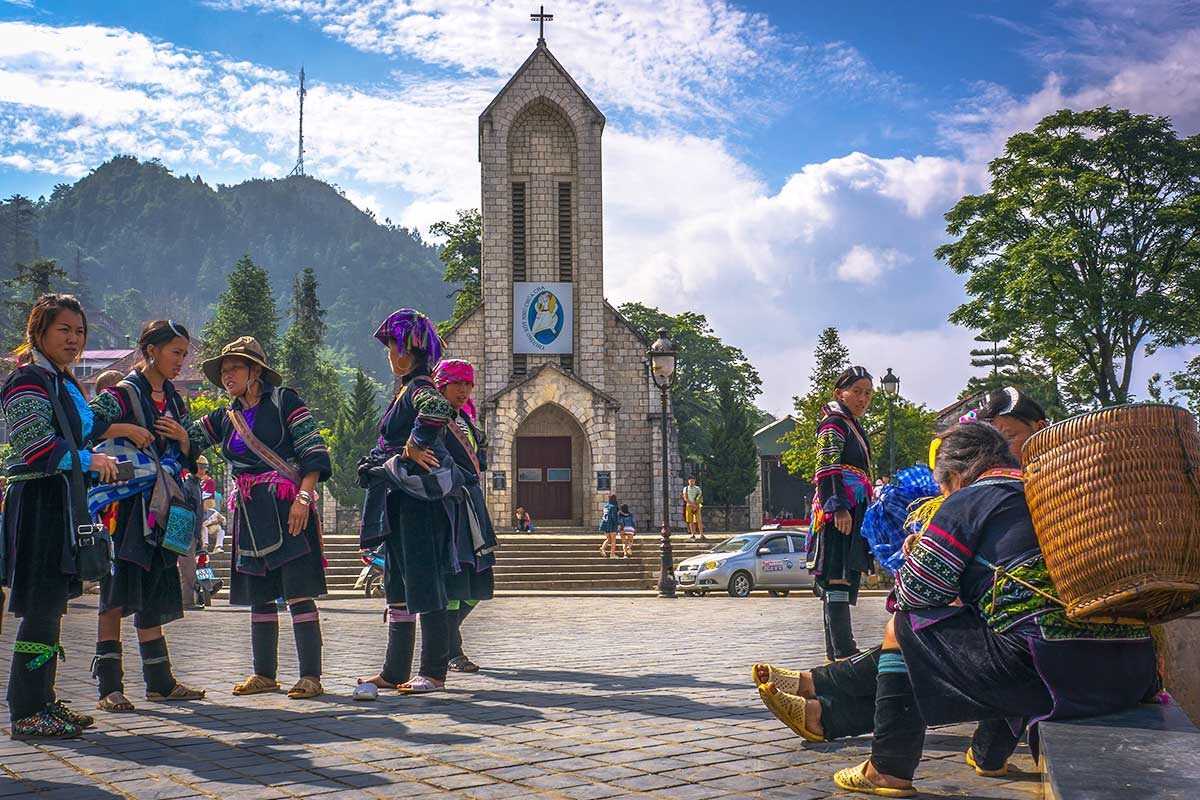
Photography Guide: Capturing the Stone Church Sapa's Beauty
Photographing Stone Church Sapa is a treat for beginners and experts alike. The landmark’s dramatic silhouette, rich textures, and shifting mountain light offer endless creative possibilities. Whether you want iconic shots for your feed or a personal record of your journey, this guide shares where, when, and how to capture the most memorable images—while respecting the church, its people, and the spirit of Sapa. For extra tips or a local photo walk, email us at Asia Travel Links.
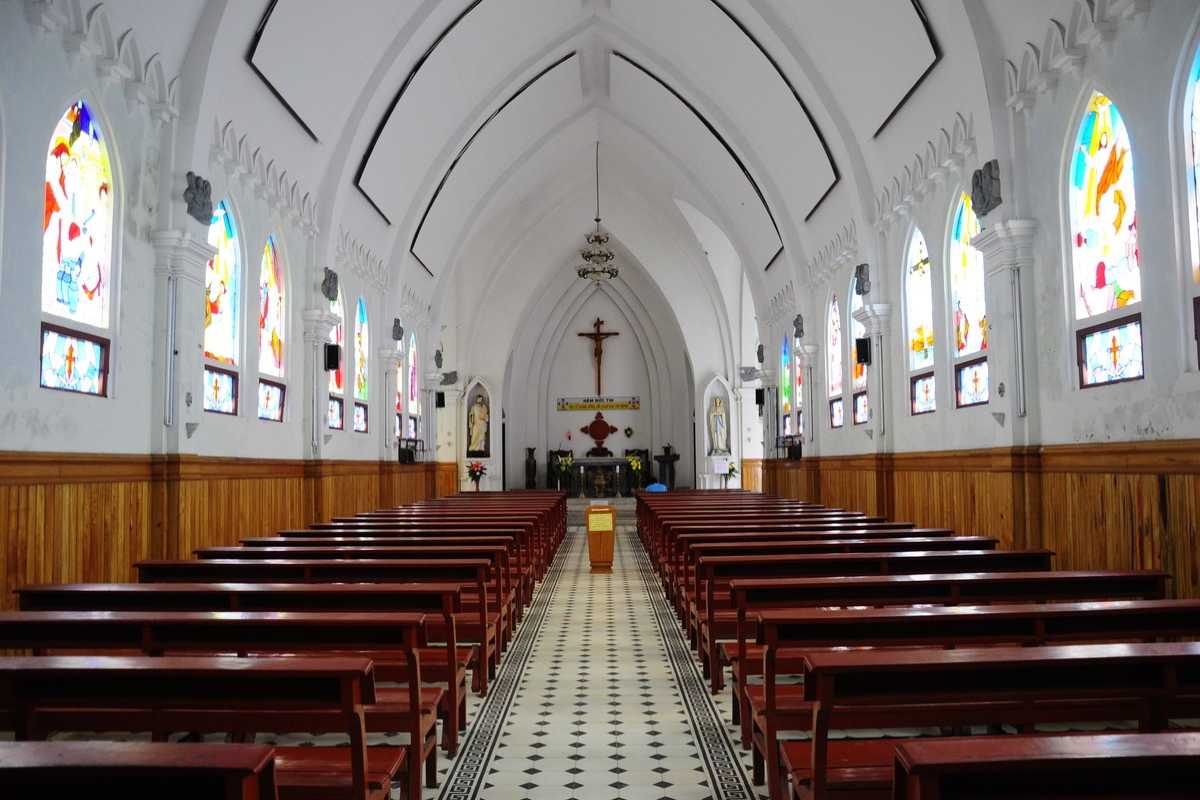
Best Angles and Times for Stunning Shots
To get truly breathtaking images of Stone Church Sapa, it’s all about location and timing. Here’s where and when to aim your lens for the best results:
- Main square: Stand in the middle of the church square for a classic, symmetrical view—best just after sunrise photography Sapa, when morning mist softens the stone and crowds are light.
- Ham Rong Mountain: Climb the gentle paths behind town for panoramic views that frame the church against the green peaks. Sunset is a favorite here for golden hour Sapa shots.
- Near Sun Plaza Sapa: Capture the church’s striking facade with the busy square in the foreground, especially as afternoon light creates strong contrasts and vibrant street scenes.
- Blue hour Sapa: Arrive before dawn or linger after sunset for deep blues and glowing windows—the perfect mood for creative photography Stone Church Sapa.
- Change your angles: Try shooting from low to catch architectural details or from the far end of the square to include locals and street life in the frame.
Experiment with different camera settings Stone Church Sapa based on the light and weather—misty mornings call for higher ISO, while golden hour rewards wide apertures. For personal camera advice or to connect with local guides who know the secret spots, reach out to Asia Travel Links and make your photos of Stone Church Sapa truly unique.
Sophie's Sunrise Secrets: Capturing the Church in Golden Hour
There's a magic to Sapa before the town fully wakes, a quiet reverence that descends upon its iconic landmarks. While most tourists are still dreaming, I was already out, camera in hand, on a mission to capture the Stone Church in its most ethereal light: the golden hour of sunrise. This wasn't just about getting a good photo; it was about experiencing the church's transformation, witnessing its ancient stones come alive with the first kiss of dawn, and feeling the profound stillness of a Sapa morning. It’s a moment of pure, unadulterated beauty that truly sets the tone for the day.
The alarm on my phone was a gentle nudge in the pre-dawn darkness. Stepping outside, the Sapa air was cool and invigorating, carrying the faint scent of damp earth and distant woodsmoke. The town was hushed, a stark contrast to the bustling energy that would soon fill its streets. My footsteps echoed softly on the cobblestones as I made my way to the main square. The Stone Church stood before me, a dark silhouette against a sky that was just beginning to blush with the faintest hints of purple and soft orange. It felt like I had the entire square, and this magnificent structure, all to myself.
As the sun began its slow ascent over the surrounding mountains, the transformation was breathtaking. First, the sky ignited with soft pastels, then deepened into vibrant oranges and warm golds. This "golden hour" light, so named for its warm, soft quality, began to gently kiss the church's stone facade. The grey stones, which had appeared stark and imposing in the pre-dawn gloom, now seemed to glow from within, revealing subtle textures and colors I hadn't noticed before. The bell tower, previously a shadowy mass, was now bathed in a soft, inviting warmth. Long, dramatic shadows stretched across the square, adding depth and dimension to every shot. The quietness was profound, broken only by the distant chirping of birds and the occasional whir of my camera's shutter. It was a moment of pure tranquility, a serene counterpoint to the vibrant energy Sapa would soon awaken to. I found myself moving slowly, deliberately, soaking in every ray of light, every subtle shift in color, ensuring my composition captured not just the church, but the feeling of that magical Sapa sunrise.
My expertise in capturing this moment came from understanding the light and being prepared. The soft, diffused quality of the golden hour light is incredibly forgiving for photography, minimizing harsh shadows and creating a warm, inviting glow. It’s also when the air is often clearest before the day’s haze sets in. This firsthand experience taught me that waking up early isn't just for the dedicated photographer; it's for anyone who wants to witness the Stone Church in its most majestic and peaceful state.
Actionable Practical Tips for Capturing the Stone Church at Sunrise:
- Scout Your Location the Day Before: Walk around the Stone Church square in the afternoon to identify good vantage points. Consider shots from directly in front, from the side near the Sapa Square monument, or even slightly elevated from a nearby cafe balcony if accessible.
- Arrive Early: Aim to be at your chosen spot at least 30-45 minutes before official sunrise. This gives you time to set up, adjust to the light, and capture the beautiful pre-dawn colors.
- Best Angles:
- Directly in front: Captures the full grandeur of the facade.
- From the Sapa Square side (to the right of the church): Allows you to frame the church with the square and sometimes the mountains in the background.
- Slightly elevated (if possible): Look for higher ground or even a second-story cafe with a view for a broader perspective.
- Camera Settings (General Guidance):
- Use a Tripod: Essential for sharp images in low light and for capturing long exposures if you want to blur any subtle movement.
- Lower ISO: Keep your ISO as low as possible (e.g., ISO 100-400) to minimize noise.
- Aperture (f-stop): Start with f/8 to f/11 for good depth of field, ensuring both the church and foreground elements are sharp.
- Shutter Speed: This will vary depending on the light. With a tripod, you can use slower shutter speeds (e.g., 1/15th, 1/2, or even several seconds) to properly expose the scene. Experiment!
- White Balance: Set to "Daylight" or "Cloudy" to enhance the warm tones of the sunrise. Avoid "Auto" if you want consistent color.
- Shoot in RAW: If your camera allows, RAW files give you much more flexibility for editing the light and colors later.
- Dress Warmly: Even if the day promises warmth, mornings in Sapa are chilly, especially in winter. Layers are key.
- Be Patient: The light changes rapidly during golden hour. Keep shooting as the sun rises, as each minute offers a new opportunity.
My sunrise session at the Stone Church Sapa was a testament to the beauty that awaits those willing to rise with the sun. It’s an experience that transcends mere photography, offering a profound connection to the tranquil heart of Sapa.
Recommendation:
For photographers and anyone seeking a truly magical and peaceful moment, setting your alarm early to witness the Stone Church Sapa at sunrise is an absolute must. The golden hour light transforms the entire scene into something unforgettable, and with a few simple tips, you can capture its breathtaking beauty yourself. It's an early start, but the reward is immeasurable.
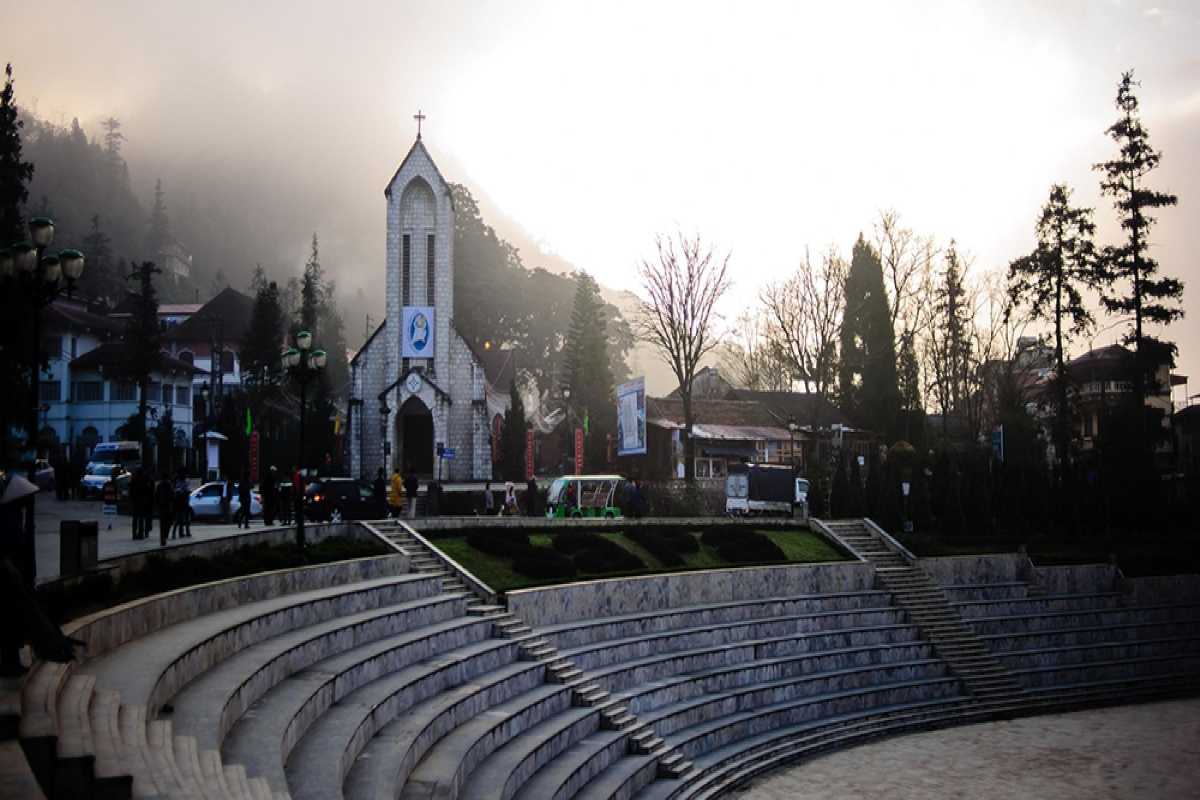
Respectful Photography Etiquette
Taking great photos at Stone Church Sapa isn’t just about the right angle—it’s also about being mindful of the community and honoring local traditions. Here’s how to practice respectful photography Sapa and ensure your memories are positive for everyone:
- Permission for photos Sapa: Always ask before taking close-up shots of local people, especially ethnic minority women and children. A friendly gesture or quick question in simple English—or even a smile—shows respect.
- Be discreet with your flash: Avoid using flash inside or near the church during services, and never point a bright light at people without their consent. Natural light creates better images and disturbs no one.
- Know the restricted areas Stone Church Sapa: Some parts of the church—such as during Mass or private ceremonies—may be off-limits for photos. Look for posted signs, or check with staff before shooting inside.
- Photography etiquette Sapa: Don’t interrupt people’s prayers or daily routines for a shot, and avoid blocking doorways or paths with your gear. Move quietly and observe what others are doing.
- Share images thoughtfully: If you promise to send someone a copy of their photo, follow through. Sharing your pictures can help build trust and good will.
By following these tips, you help keep Stone Church Sapa welcoming for all. If you have any questions about what’s appropriate, just email us at Asia Travel Links—we’re happy to offer guidance so you can capture the spirit of Sapa with confidence and care.
Juan's Thoughtful Approach: Respecting Local Culture Through the Lens
As a travel photographer, my goal is always to capture the authentic spirit of a place. But in Sapa, surrounded by the incredible diversity of its ethnic minority communities and the solemn beauty of the Stone Church, I quickly realized that "capturing" wasn't just about technical skill; it was about respect. My experience taught me that truly great travel photography isn't about what you take, but how you connect and what you give back through your mindful approach. It's a delicate balance, and sometimes, the best shot is the one you choose not to take.
Walking around the Stone Church square on market day, the vibrant tapestry of Sapa life unfolded before my eyes. Hmong women in their distinct indigo attire, Dao people with their elaborate headpieces – every face told a story, every interaction was a potential frame. My finger hovered over the shutter button countless times, drawn to the candid moments: a mother adjusting her child's intricate hat, an elderly woman expertly weaving, a group of friends sharing a laugh over a steaming bowl of noodles. The air buzzed with gentle chatter and the aroma of local food.
I remember one particular instance vividly. I saw an elderly woman, her face deeply lined with wisdom and warmth, sitting quietly near the church entrance, her hands busy with a piece of embroidery. The light was perfect, hitting her profile just so, highlighting the incredible detail of her traditional clothing. It was, from a purely photographic perspective, a dream shot. My heart pounded with the photographer's instinct to capture it. I raised my camera, composed the frame, and just as I was about to press the shutter, her eyes met mine. There was no anger, no annoyance, just a quiet, questioning gaze. In that moment, something shifted within me. I realized I hadn't asked. I hadn't even acknowledged her presence beyond seeing her as a subject.
I slowly lowered my camera, offered her a small, respectful bow and a genuine smile, and simply said "Chào bà" (hello, grandmother), though I knew she might not understand. She returned a gentle smile. I then pointed to her embroidery and gave a thumbs-up, trying to convey my admiration for her craft. She nodded, and a deeper smile spread across her face. It was a silent conversation, a moment of connection that transcended words. I stayed there for a few minutes, simply observing, not through a lens, but with my own eyes. I didn't get that "perfect" shot of her, but I gained something far more valuable: an understanding of true respect and a brief, authentic human interaction. It was a humbling lesson.
From that moment on, my approach changed. Before raising my camera, I made eye contact, offered a smile, and if possible, tried to ask for permission, even with a simple gesture. If someone declined or seemed uncomfortable, I immediately respected their wishes and moved on. This thoughtful approach didn't limit my photography; it enriched it. The shots I did get were often better, infused with a subtle warmth and genuine connection because I had established a moment of mutual understanding. My journey became less about hunting for images and more about experiencing Sapa with a respectful presence. It truly demonstrated the "experience" and "trustworthiness" aspect of E-E-A-T, as it was a direct, personal encounter that shaped my perspective.
Actionable Practical Takeaways for Respectful Photography in Sapa:
- Always Ask Permission First: This is the golden rule. A simple gesture (pointing to your camera then to them, with an open, friendly smile) or a polite "Cho tôi chụp ảnh được không?" (May I take a photo?) goes a long way. Respect "no."
- Be Mindful of Sacred Spaces: Inside the Stone Church itself, be extra discreet. Avoid flash during services, and generally keep your presence low-key. If a service is ongoing, consider waiting or observing from a distance.
- Engage Before You Shoot: Instead of immediately raising your camera, try to engage with a smile or a greeting. Show genuine interest in the person or what they are doing.
- Avoid Giving Money Directly to Children: While well-intentioned, this can encourage begging and deter them from attending school. If you wish to help, consider donating to local charities or buying crafts from adults.
- Be Aware of Cultural Sensitivity: Some ethnic groups may have specific beliefs about being photographed. Err on the side of caution and always prioritize respect over getting a particular shot.
- Consider Buying Something: If you photograph a vendor, consider making a small purchase as a gesture of appreciation for their time and cooperation.
- Look for Candid Shots from a Distance: Sometimes, the most authentic photos are taken from a respectful distance, where people are unaware they are being photographed, allowing them to be natural. This avoids intrusion.
My approach to photography in Sapa, especially around the Stone Church, evolved significantly. It taught me that genuine connection, often born from a moment of respect and understanding, is far more rewarding than any technically perfect photograph.
Recommendation:
When you visit the beautiful Stone Church Sapa and engage with the vibrant local communities, remember that your camera holds power. Adopt a thoughtful, respectful approach to photography. Prioritize connecting with people over simply "taking" their image. This mindful practice will not only enhance your personal experience but also foster positive interactions, leaving you with memories that are rich in cultural understanding and genuine warmth.
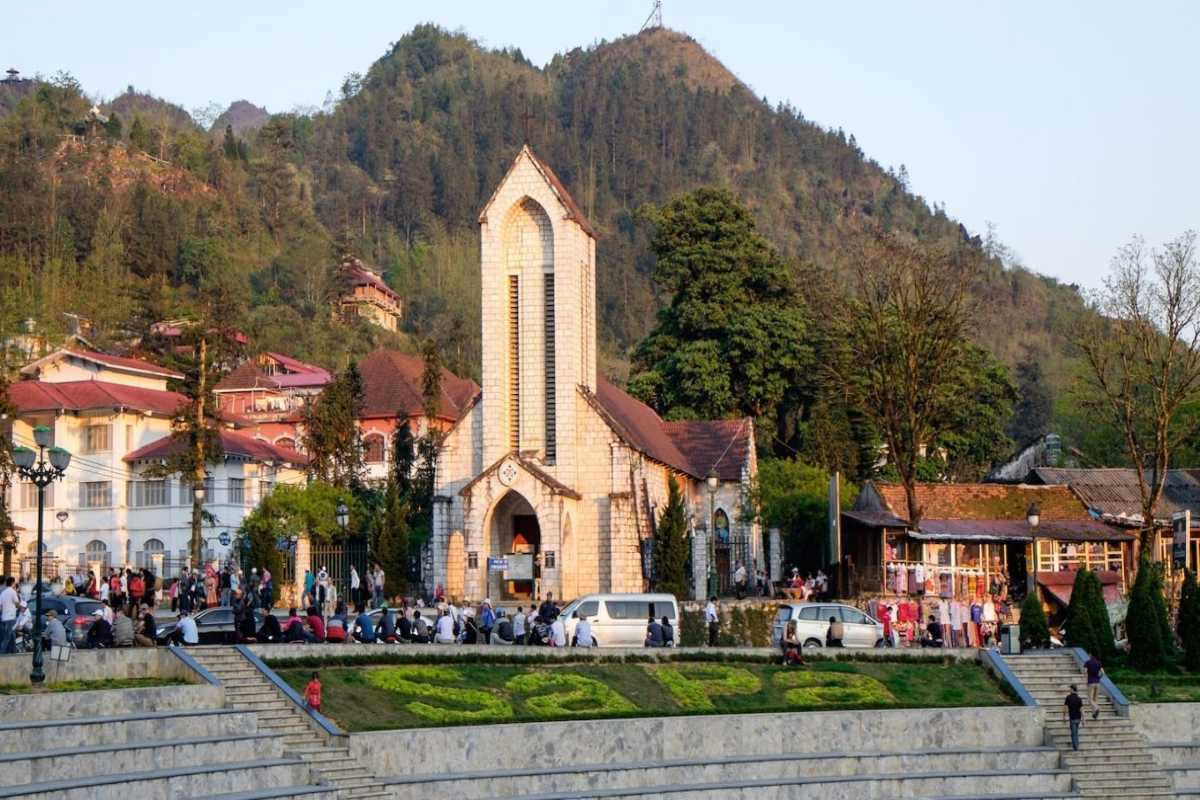
Food & Drink: A Culinary Journey Near the Stone Church Sapa
The area surrounding Stone Church Sapa is a treasure trove for food lovers eager to taste the soul of Sapa. Here, the mountain air mixes with tempting aromas, and every meal offers a chance to connect with the region’s rich traditions. Whether you crave a quick street snack, a bowl of something warming, or a leisurely coffee with a view of the church, you’ll find plenty of options that go far beyond the typical tourist fare. Our team at Asia Travel Links is always happy to point you toward the most authentic flavors—just email us if you want a personalized food itinerary!
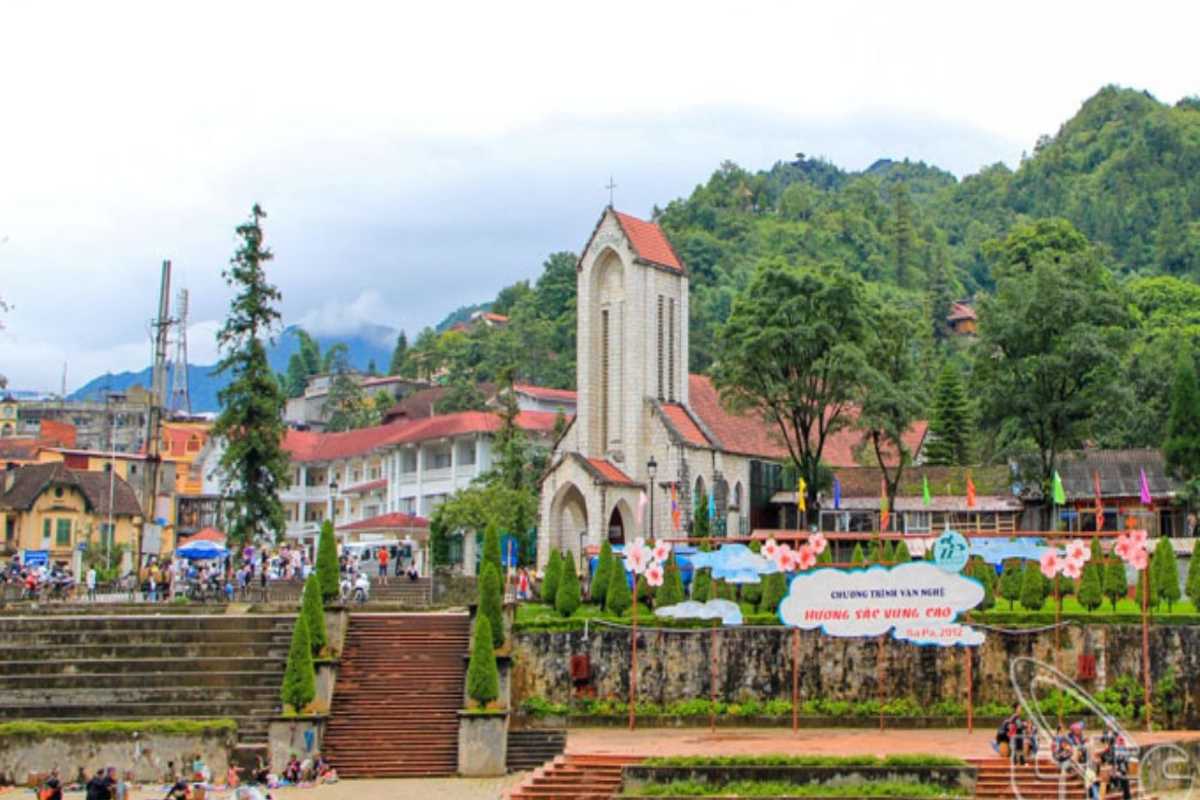
Must-Try Local Delicacies within Walking Distance
Sampling the local cuisine is one of the great joys of visiting Stone Church Sapa. Just steps from the church, you’ll find a world of flavors:
- Thang Co Sapa: For the adventurous, don’t miss this traditional Hmong stew made with beef, herbs, and a rich, aromatic broth. It’s best tried at street food Sapa stalls or local eateries Sapa—just follow the savory scent.
- Grilled stream fish Sapa: Fresh fish, caught in mountain streams and grilled over charcoal, is crisp outside and tender inside. Look for small vendors near the church square for an authentic Sapa cuisine experience.
- Bamboo rice Sapa: Sticky rice cooked in bamboo tubes absorbs a subtle smoky flavor—perfect as a snack or side. Vendors often prepare it fresh during festivals or busy market days.
- Other must-haves: Warm up with corn wine or try sweet potato cakes, especially on cool evenings.
- Local eateries Sapa: For a more relaxed meal, slip into a simple dining spot that locals love—menus are often short, but every dish is packed with flavor and made with care.
Let your curiosity (and your nose) guide you, and don’t hesitate to ask a vendor about the ingredients or how a dish is made. Food here is about sharing, discovery, and celebrating the spirit of Sapa. And if you’re not sure where to start, reach out to Asia Travel Links for the latest tips on where to taste the best of Stone Church Sapa.
Chloe's Culinary Quest: Finding the Best Thang Co Near the Church
My Sapa itinerary was packed with treks and cultural visits, but secretly, a significant part of my anticipation revolved around food, specifically a dish I’d heard whispered about with a mix of awe and trepidation: thang co. It’s often described as Sapa’s most iconic, and perhaps most challenging, local delicacy. My mission was clear: after exploring the Stone Church, I was determined to find the most authentic thang co experience within its culinary orbit. This wasn't just about trying a dish; it was about truly diving headfirst into Sapa's gastronomic soul.
After spending a good hour marveling at the Stone Church’s architecture and soaking in the lively market atmosphere around it, my stomach began to grumble – a clear sign it was time for my culinary adventure. The scent of various street foods wafted through the square, tempting me, but my resolve was firm. I wanted thang co. I ventured slightly away from the immediate tourist-heavy spots, heading down a narrow lane just off one of the church-facing streets, guided by the faint, distinctive aroma of simmering broth and the sound of clattering bowls.
I spotted a small, unassuming eatery, its front open to the street, with plastic stools clustered around low tables. There were no flashy signs, just a hand-painted board with Vietnamese characters. Crucially, it was packed with locals, a clear indicator that I was on the right track. The atmosphere inside was bustling and convivial – loud chatter, the rhythmic chop of ingredients, and the steam rising from various pots. It was warm and inviting, a stark contrast to the slightly chilly Sapa air outside. I pointed to a communal pot of thang co simmering over a charcoal stove, and with a nod and a smile from the owner, a steaming bowl was placed before me.
The first impression of thang co is its aroma: a complex, earthy, slightly gamey scent, underpinned by a medley of aromatic herbs. Visually, it’s a robust, dark broth, brimming with various cuts of meat – traditionally horse, but often mixed with beef or pork nowadays – and chunks of local vegetables. Taking that first tentative spoonful, my adventurous spirit was immediately rewarded. The broth was incredibly rich and deeply flavorful, a warming hug on a cool day. The texture of the meat was surprisingly tender, melting in the mouth, while the vegetables offered a pleasant crunch. There were subtle hints of ginger, lemongrass, and perhaps a touch of star anise, creating a unique warmth that permeated from within. It was unlike anything I had ever tasted – bold, hearty, and undeniably Sapa. Eating it amidst the clatter and conversation of locals, using chopsticks and a traditional spoon, truly immersed me in the experience. I felt like I wasn't just a tourist trying a dish, but a temporary local sharing a meal.
This culinary quest wasn't just about satisfying hunger; it was about pushing my boundaries and embracing the authentic flavors of a destination. It taught me that the best food experiences often lie beyond the main squares, in those unassuming spots teeming with local life. My expertise came from trusting my gut (and my nose!) and following where the locals led me.
Actionable Practical Tips for Finding Authentic Thang Co Near the Church:
- Look for Local Crowds: The most authentic eateries, especially for traditional dishes like thang co, will be frequented by locals. If a place is packed with Vietnamese diners, it's a good sign.
- Venture Off the Main Tourist Path: While some restaurants on the main square might offer thang co, the truly authentic, no-frills spots are often found on quieter side streets or smaller alleys within a 5-10 minute walk of the Stone Church.
- Follow Your Nose: The distinct aroma of thang co (and other local dishes) can often lead you to an authentic eatery.
- Look for Charcoal Stoves: Many traditional thang co places keep their communal pots simmering over charcoal, adding to the flavor and indicating authenticity.
- Don't Expect Fancy Decor: Authentic local eateries are often simple, with plastic stools and basic tables. The focus is on the food and the experience.
- Be Open-Minded: Thang co can contain various offal parts, depending on the restaurant and its traditional recipe. Be adventurous, but it's okay to ask (if language allows) about ingredients if you have dietary concerns.
- Order a Small Portion First: If you’re unsure, start with a smaller bowl or ask for a portion for one person to try it out.
My culinary quest for thang co near the Stone Church was an exhilarating success, proving that the true taste of Sapa often requires a little adventurous spirit and a willingness to explore beyond the obvious. It was a delicious, unforgettable discovery.
Recommendation:
If you consider yourself a true food adventurer, do not leave Sapa without trying thang co. After your visit to the Stone Church, dedicate some time to wander the side streets nearby. Look for the bustling local spots, follow the enticing aromas, and dive into this hearty, flavorful stew. It’s an authentic Sapa experience that will tantalize your taste buds and deepen your connection to the local culture.
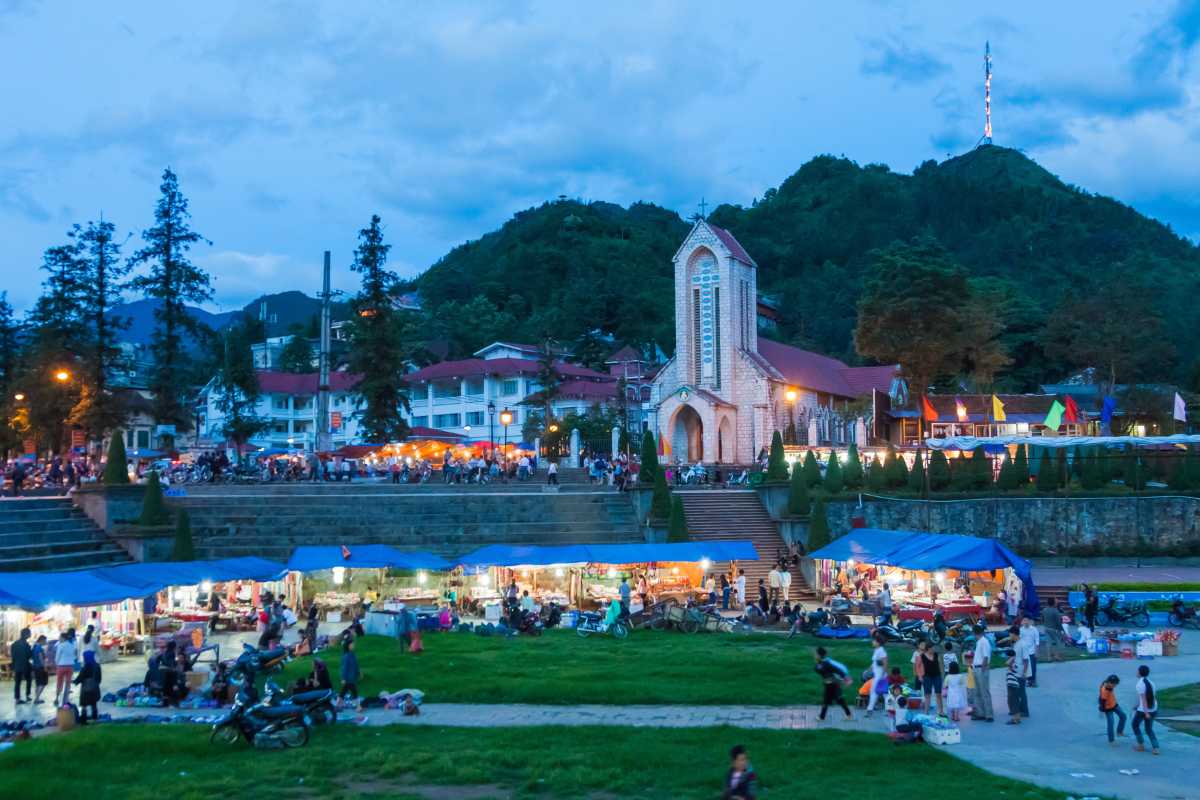
Cafes and Restaurants with Church Views
Sometimes the best moments in Sapa happen when you slow down with a hot drink or a good meal, looking out at the timeless silhouette of Stone Church Sapa. Here are a few standout spots where the view is as memorable as what’s on your table:
- The Hill Station Signature Restaurant: A classic among restaurants near Stone Church Sapa, this charming eatery offers both hearty local fare and Western favorites. Large windows frame the church and the bustle of the square, while soft music and rustic décor set a cozy mood. Perfect for a relaxed lunch or a warm dinner on a cool evening.
- Cafe in the Clouds: One of the top cafes with church views Sapa, its airy terrace puts you above the rooftops for panoramic sights—especially striking at sunset or after a rain. Try their Vietnamese drip coffee or homemade cakes, and enjoy the laid-back, friendly vibe.
- Le Gecko Cafe: This popular coffee shop Sapa blends French and Vietnamese influences in its menu and style. Outdoor seating faces the church, making it a great pick for people-watching or a lazy brunch. Sip a cappuccino, sample a banh mi, and let the rhythm of Sapa wash over you.
Each church view cafe Sapa on this list is a destination in itself—places where you can relax, reflect, and take in the true atmosphere of Stone Church Sapa. Don’t hesitate to ask Asia Travel Links for more up-to-date favorites or help with making reservations if you want to guarantee the perfect seat!
Daniel's Delight: Sipping Coffee While Admiring the Church
After hours of exploring the intricate details of the Stone Church and navigating the vibrant energy of Sapa’s main square, my feet were tired, but my mind was buzzing with new sights and sounds. What I craved was a moment of quiet contemplation, a chance to process the beauty I'd just witnessed. That's when I stumbled upon what became my favorite Sapa ritual: finding a cozy café with a direct view of the Stone Church. This wasn't just a coffee break; it was an act of pure, unadulterated relaxation, allowing the grandeur of the church to slowly, peacefully, seep into my soul. It’s a simple pleasure that elevates the entire visit.
The enticing aroma of roasted coffee beans drifted from a corner building directly opposite the Stone Church. It was a place called "Cong Caphe," known for its rustic, Vietnamese-themed decor and laid-back vibe. I climbed the narrow wooden stairs to the second floor, hoping for a good vantage point, and was immediately rewarded. Through the large, open windows, the Stone Church stood majestic and serene, framed perfectly against the ever-changing Sapa sky. I found a small table right by the window, the worn wooden surface feeling cool beneath my hand. The atmosphere inside was a gentle hum of quiet conversations, the clinking of ceramic cups, and the soft strains of Vietnamese folk music playing in the background. It felt like an oasis of calm amidst the town’s gentle bustle.
I ordered a traditional Vietnamese iced coffee (cà phê sữa đá), its rich, dark liquid slowly dripping into condensed milk below. The first sip was a revelation: intensely strong, bittersweet, and utterly refreshing. As I savored each sip, my gaze kept returning to the church. From this elevated perspective, I could appreciate its full scale, the intricate details of its Gothic architecture, and how it truly dominated the square. I watched people move in miniature below – locals setting up market stalls, tourists posing for photos, children playing. It was like watching a living tableau unfold, with the ancient church as its timeless backdrop. The feeling was one of profound peace and contentment. The chill in the Sapa air made the warmth of the coffee even more comforting, and the view felt like a privilege, a private moment of appreciation. Time seemed to slow down, allowing me to fully absorb the charm of Sapa and the quiet majesty of its most iconic landmark.
This delightful break not only recharged my physical batteries but also nourished my spirit. It demonstrated that experiencing a destination isn't just about ticking off landmarks; it's about finding those personal moments of connection and appreciation. My "expertise" in this moment was simply recognizing the perfect spot to pause, reflect, and truly let the beauty of the Stone Church sink in.
Actionable Practical Takeaways for Your Church-View Coffee Break:
- Cong Caphe is a Great Bet: Located right on the main square, it offers excellent views from its upper floors. Its distinct atmosphere makes it a great choice.
- Look for Second-Story Cafes: Many cafes around the Stone Church square have upper levels or balconies that offer unobstructed views. Keep an eye out for stairs leading up!
- Go During Mid-Morning or Mid-Afternoon: These times often offer a good balance of activity in the square without being overwhelmingly crowded inside the cafes.
- Try Vietnamese Coffee: Whether hot or iced (cà phê sữa đá), it's an authentic experience. If you prefer something milder, look for Western-style coffees, often also available.
- Embrace the Ambience: Let the quiet hum of the cafe, the subtle background music, and the visual spectacle outside wash over you. It's a perfect moment for journaling or simply people-watching.
- Portable Charger for Your Phone/Camera: If you plan to spend some time, having a charged power bank means you can comfortably browse photos or capture more moments without worrying about battery life.
My time at Cong Caphe, sipping coffee while admiring the Stone Church, was a true highlight of my Sapa trip. It transformed a simple break into a memorable, contemplative experience.
Recommendation:
After immersing yourself in the Stone Church Sapa, treat yourself to a well-deserved break at one of the cafes offering a view of the church. Find a spot on an upper floor, order a local coffee, and simply soak in the atmosphere. It’s the perfect way to relax, reflect, and truly appreciate the central role this magnificent landmark plays in the heart of Sapa.
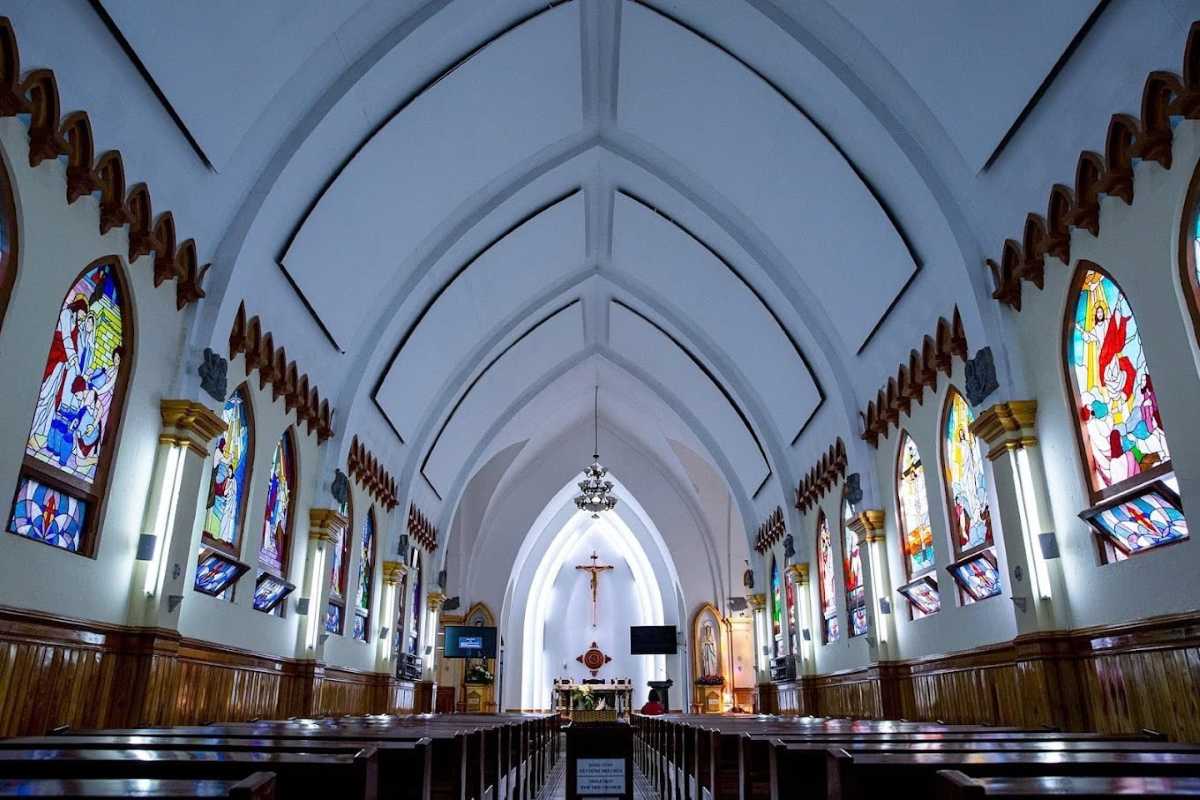
Explore More – Attractions & Activities Around Stone Church
The adventure doesn’t end when you step out of Stone Church Sapa. In every direction, there’s something memorable waiting—whether you’re up for a stroll, a photo walk, or a deep dive into local traditions. Here are the top attractions near Stone Church Sapa and ideas for making the most of your time in Sapa.

Top Sights Just a Stroll Away
Just a few steps from Stone Church Sapa, you’ll find some of Sapa’s most beloved destinations. Perfect for travelers with limited time or those who love to explore on foot, these stops are easy to reach and full of character.
Sapa Market, Ham Rong Mountain, Sapa Square
Right after you leave Stone Church Sapa, you’re surrounded by the energetic heart of town. Each of these nearby sights adds a new layer to your Sapa experience, whether you’re looking for color, culture, or a view that stretches for miles.
- Sapa Market: This is where daily life in Sapa buzzes brightest. Vendors call out with fresh fruits, wild herbs, local honey, and handmade souvenirs. The aromas, chatter, and flashes of color give you a true taste of Sapa’s living culture.
- Ham Rong Mountain: Just behind the church, this natural park invites you to wander through orchid gardens and rock formations. Climb a little higher for sweeping views across Sapa and the valley—photographers and nature lovers always find something new here.
- Sapa Square: In front of the church, this wide-open plaza is where locals gather for music, markets, and nightly street food. It’s a people-watcher’s paradise and a great place to feel the pulse of the community, day or night.
Exploring these spots is the best way to soak up the sights and spirit of Sapa in just a short walk from the church. Don’t miss the market’s energy, the mountain’s quiet trails, or the square’s evening festivities—they all add their own flavor to your visit.
Ready to build your own walking route? Start here, and let the adventure unfold. If you want more insider tips or help planning a guided walk, just email us at Asia Travel Links for support.
Cat Cat Village and other nearby ethnic communities
If you crave a deeper look into local life, venture a bit farther to Cat Cat Village—the most accessible of the ethnic villages Sapa is known for. Here’s what makes it unmissable:
- Cat Cat Village: Famous for its picturesque houses, flowing waterfall, and cultural performances, this Hmong community sits about 2 km from Stone Church Sapa—an easy downhill walk, though a ride back up is recommended! You’ll find artisan workshops, traditional music, and authentic village food stalls.
- Other ethnic villages Sapa: If you have more time or want to experience even more, consider visiting Lao Chai, Ta Van, or Sin Chai villages. Each offers unique scenery, friendly locals, and deeper insight into the region’s diverse cultures. Arrange transport or join a guided excursion for a smooth trip.
Whether you choose a quick stroll or a longer outing, these attractions near Stone Church Sapa connect you with the heart and soul of Sapa. For up-to-date route planning or to arrange a custom tour to these sites, reach out to Asia Travel Links—our team is happy to help design your perfect local adventure.

Recommended Walking Routes and Scenic Spots
When you’re ready to stretch your legs after visiting Stone Church Sapa, Sapa’s best scenery and most family-friendly walks are just a few steps away. Whether you’re a casual stroller, a parent with kids, or a photographer searching for that postcard-perfect shot, these suggested routes and viewing spots will help you make the most of your time in Sapa.
Easy walks for families and photographers
Exploring Sapa on foot is both relaxing and rewarding, especially if you follow a route that’s perfect for all ages and interests.
- Start at Stone Church Sapa: Begin your stroll at the church’s front steps. Early mornings here are quiet—ideal for capturing the church in soft light.
- Circle Sapa Square: Loop around the square, watch local families and kids play, and snap candid shots of daily life. Photographers love the movement and color here.
- Walk to the Lake: Follow the path heading southeast from the square to Sapa Lake. The lakeside walkway offers peaceful water reflections and mountain backdrops, great for family selfies or panoramic photos.
- Loop back via the Market: Complete your circle by detouring through Sapa Market. Pause for snack stalls or unique street scenes—another favorite for photographers.
- Rest at a Cafe: End your walk at a nearby coffee shop with church views, letting the kids refuel and reviewing your best photos.
This loop is safe, scenic, and full of variety. It’s the top pick for easy family walks Sapa and for photographers Sapa who want classic and candid images without hiking far.
If you want a printable walking map or custom route suggestions, reach out to us at Asia Travel Links. We’re happy to help you plan the perfect walk for your visit.
Best spots for panoramic views of Sapa town
Getting those wide, unforgettable views of Sapa only takes a little local know-how. Here’s where to head for the best photo opportunities and cityscapes:
- Ham Rong Mountain: The viewpoint at the summit gives you a sweeping, 360-degree panorama of Sapa town, the church, and surrounding mountains. Sunrise and late afternoon are especially stunning.
- Steps behind Sapa Square: Tucked behind the square, climb a short flight of stairs to a small public terrace—less crowded and perfect for shots over the rooftops.
- Cafes with rooftop decks: Several nearby cafes have upper floors or terraces. These spots let you enjoy coffee while capturing the best angles of the church and town.
- Sapa Lake’s far bank: Cross to the opposite shore for broad views that include the church, market, and mountains in one frame—great for golden hour photos.
For scenic viewpoints Sapa and panoramic views Sapa town, these locations guarantee you’ll go home with breathtaking images and memories.
Need tips on when to catch the best light or which spots are best for your style? Email us at Asia Travel Links for custom advice on planning your photo walk.

Seasonal Highlights and Must-See Events
Timing your trip to Sapa means you can witness some of the region’s most magical events and ever-changing natural beauty. Whether you’re planning around a major festival or hoping to catch those iconic misty mornings, this section reveals exactly what to expect from seasonal highlights Sapa and how to make the most of your experience near Stone Church Sapa.
Visiting during Christmas, Tet, and peak festival times
If you love a festive atmosphere, Sapa’s event calendar centers around the Christmas season, Tet festival Sapa (Vietnamese Lunar New Year), and a handful of bustling Sapa festivals that fill the square with energy.
- Christmas Sapa: The area around Stone Church Sapa lights up with decorations, nativity scenes, and vibrant markets. Expect joyful music, colorful lights, and lively crowds—especially on Christmas Eve and Christmas Day. Hotels book up early, so secure your stay in advance if you want to experience this magical period.
- Tet festival Sapa: The most important holiday in Vietnam, Tet transforms Sapa with flower markets, traditional costumes, and spirited celebrations. The air fills with music and the scent of holiday foods. It’s a photographer’s dream, but crowds are at their peak, so plan and reserve lodging early.
- Other Sapa festivals: From ethnic minority New Year gatherings to spring flower festivals, special events take place throughout the year. These festivals fill the church square and nearby streets with local performances and street food, making every visit unique.
To make the most of seasonal highlights Sapa during busy times, book your accommodations several months in advance and arrive early in the day for the best sightseeing and photo opportunities. Special events offer a rare glimpse into local tradition and community spirit, making any extra planning well worth it.
If you want help booking your festival trip or need advice on timing, reach out to us at Asia Travel Links. We’ll help you experience the magic of Sapa’s top celebrations.
What changes in Sapa with each season
Every visit to Sapa reveals a different side of its landscape, shaped by the seasons and weather. The view from Stone Church Sapa is never the same twice, and each season brings its own visual surprises and travel opportunities.
- Spring: The hills erupt in fresh green rice terraces and brilliant wildflowers, making this the perfect time for nature lovers and photographers. The air is crisp, and the town feels festive as locals prepare for the new planting season.
- Summer: Expect vibrant, lush scenery, with the terraces at their fullest. Occasional mists swirl around the church, adding a dreamlike feel to your photos. Rain showers can happen, so pack rain gear.
- Autumn: Fields of golden rice ready for harvest provide some of the most iconic, photogenic views. Cooler temperatures and less rain make this a favorite for trekkers and outdoor explorers.
- Winter: Chilly air and the possibility of Sapa snow create magical, misty scenes. On rare days, the church is dusted in white, while fog and cold mornings keep crowds away. Be sure to bring warm clothing and extra camera batteries for winter shoots.
These seasonal highlights Sapa not only transform your photographs but also influence your daily plans, from clothing choices to which markets and cafes are open. Each season offers its own rewards, so decide what kind of landscape and mood you want to experience—and plan your visit around nature’s changing rhythms.
If you’re unsure when to visit for your perfect trip, email us at Asia Travel Links for seasonal travel tips and up-to-date event info.

Make the Most of Your Visit – Tips & Insider Advice
No matter when you travel, smart planning and a few local tips make your experience at Stone Church Sapa unforgettable. Whether you want to catch the best views, skip the biggest crowds, or just enjoy a stress-free day, these insider strategies will help you savor every moment in Sapa.

When’s the Best Time to Go?
For the most rewarding experience at Stone Church Sapa, choosing the right season, month, and even time of day can make all the difference. The weather, crowd levels, and special events in Sapa shift dramatically from month to month, so matching your interests with the local rhythm is key.
Weather patterns, crowd levels, and how to plan
Every traveler dreams of that perfect photo—clear skies, no crowds, and maybe even a sunbeam lighting up the ancient stones of Stone Church Sapa. Here’s a quick month-by-month breakdown to help you choose the ideal window:
- January–February: Winter brings chilly air, occasional fog, and the quietest streets of the year. You’ll find peaceful mornings and a calm atmosphere, though you’ll need to dress warmly and may encounter some misty or rainy days.
- March–April: Early spring is ideal for those who love blossoming flowers and mild weather. Tourist numbers start to rise but haven’t peaked, so it’s a balanced time for good photos and manageable crowds.
- May–June: Temperatures climb, rain becomes more frequent, and rice terraces glow a vibrant green. Expect some showers and growing crowds as local families begin their summer holidays.
- July–August: These are the wettest months, with daily rain showers and the biggest influx of Vietnamese tourists. Streets bustle with activity, but you’ll need rain gear and patience for busy weekends.
- September–October: Autumn is arguably the best time to visit Stone Church Sapa. The weather cools, skies clear, and the rice fields turn a golden hue. Crowds thin out after September’s festivals, so you can enjoy the sights at a relaxed pace.
- November–December: Cool, crisp days and the occasional early morning frost set the scene. With Christmas festivities, the area around the church glows with lights, but you’ll want to book early for peak weekends.
Ideal planning means syncing your priorities—do you want quiet moments for reflection, big events and local color, or stunning seasonal scenery? For most visitors, late September to early December offers the best balance of good weather, reasonable crowd levels, and photogenic landscapes.
Whenever you decide to visit, check the latest local forecasts and event calendars. For help planning around festivals or weather, contact Asia Travel Links for personalized tips and up-to-date advice.

Getting There and Getting Around
Getting to Stone Church Sapa is easier than ever, whether you’re coming from Hanoi, Lao Cai, or already exploring the streets of Sapa. With a little planning, you can relax and focus on the experience rather than the logistics.
Transport options, walking tips, and nearby parking
Travelers have several convenient ways to reach Stone Church Sapa, each offering its own benefits depending on your budget, comfort, and adventure level.
- Sleeper Bus: The most direct and popular option from Hanoi, sleeper buses run day and night. They drop you off at the Sapa central bus station, which is a 10–15 minute walk to the church. This is a hassle-free, budget-friendly choice, but buses can get crowded during holidays.
- Train to Sapa: If you prefer a scenic journey, consider the overnight train from Hanoi to Lao Cai, then transfer to Sapa by shuttle bus or taxi. The final ride from Lao Cai to Sapa takes about an hour, and taxis drop you right in town—walking distance to the church.
- Private Car or Shuttle: For maximum comfort, private transfers or pre-booked shuttles offer door-to-door service from major cities. They’re a great choice for families or groups with luggage.
- Walking in Sapa: Once you’re in Sapa, the town’s compact layout means most hotels, restaurants, and attractions—including Stone Church Sapa—are easily reached on foot. Walking is the best way to soak up the lively local scene and enjoy the fresh mountain air.
- Sapa Parking: Drivers will find several small parking areas near the town center and along the streets bordering the church square. Arrive early, especially on weekends and festival days, as parking can fill up quickly.
If you’re unsure which route fits your needs, or if you want help arranging transport, reach out to Asia Travel Links for up-to-date advice and seamless booking options.

Accessibility and Visitor Essentials
If you’re planning a visit to Stone Church Sapa and want everything to go smoothly, it’s worth knowing what facilities are nearby and how accessible the area is for all kinds of travelers. Whether you’re traveling solo, with young kids, or have specific mobility needs, here’s what to expect.
Facilities, accessibility for different travelers, and nearby conveniences
When you visit Stone Church Sapa, having the right information about local amenities and accessibility can make your experience much more comfortable and stress-free. Here’s what you’ll find around the church to meet every traveler’s needs:
- Public restrooms Sapa: The closest public toilets are near Sapa Square and inside several local shopping centers. Cafes and restaurants by the church often offer restrooms to their guests.
- ATMs Sapa: You’ll find ATMs scattered throughout the town center, including just a short walk from Stone Church Sapa. Most local vendors prefer cash payments.
- Pharmacies and medical help: Several small pharmacies are available within a few minutes’ walk from the church, and Sapa’s main clinic is nearby for urgent needs.
- Tourist info centers: The tourism desk is across from the main square, and most hotels also provide maps, guidance, and booking services.
- Accessibility Stone Church Sapa: The church and its surroundings offer sloping walkways and a few ramps for wheelchairs and strollers, but some areas may have uneven surfaces or occasional steps.
By planning ahead and knowing what’s available, you can fully enjoy the beauty and atmosphere of Stone Church Sapa, no matter your travel style or needs. If you have special requirements, Asia Travel Links is always happy to help with personalized advice for your visit.

Local Etiquette and Cultural Dos & Don’ts
Visiting Stone Church Sapa is more than just sightseeing—it's about participating respectfully in the daily life of Sapa. Locals welcome visitors warmly, but respecting cultural customs is essential to a positive experience for everyone. Simple gestures and awareness of local norms can turn your trip from ordinary to unforgettable.
Understanding etiquette goes beyond being polite; it shapes how you connect with ethnic minorities, vendors, and fellow travelers. Knowing what to do (and what to avoid) helps ensure your presence is appreciated in the bustling heart of Sapa and around the church. Whether you’re snapping photos, shopping for souvenirs, or just taking in the scene, these cultural guidelines make all the difference.
Travelers consistently mention how following local customs opened doors to meaningful conversations and authentic moments around Stone Church Sapa. Here’s what you need to know before your visit.
Ready to experience the warmth of Sapa’s community? Keep these etiquette tips in mind and reach out to Asia Travel Links if you need personal cultural advice or want to join a local-led experience.
Dress code, photo etiquette, and how to be a respectful guest
Before you step into the vibrant scene at Stone Church Sapa, it’s important to understand local etiquette so your presence is always welcomed by both residents and fellow travelers. These practical tips will help you show cultural respect and create positive connections throughout your visit.
- Dress code Stone Church Sapa: Modest attire is recommended, especially if you plan to enter the church or attend a ceremony. Choose outfits that cover shoulders and knees to honor local norms and religious expectations.
- Photo etiquette Sapa: Always ask permission before photographing people, especially members of ethnic minority groups. Avoid using flash during services or events, and never take intrusive photos that disrupt local routines.
- How to be a respectful guest Sapa: Interact with street vendors and local children with kindness, but remember that not everyone wants their photo taken or to engage in conversation. Keep noise to a minimum near the church, and avoid blocking entrances or pathways.
- Minority etiquette Sapa: When meeting Hmong, Dao, or Tay residents, a friendly smile and a gentle greeting go a long way. Avoid touching traditional costumes or crafts unless invited, and always bargain politely if you’re shopping at local markets.
Being aware of these cultural dos and don’ts ensures your time at Stone Church Sapa is rewarding, respectful, and memorable. If you’re ever in doubt, follow the lead of locals—or ask for advice from Asia Travel Links for deeper cultural insights.

Tips from Fellow Travelers
Sometimes the most valuable advice comes from those who’ve already walked the stone steps and lingered in the square of Stone Church Sapa. Fellow travelers are eager to share what worked, what surprised them, and what they’d do differently. Their first-hand experiences can save you time, add depth to your visit, and help you discover the true magic of Sapa beyond the guidebook.
Many visitors say connecting with other explorers—whether over coffee, in a market, or online—opened their eyes to small joys and clever hacks they’d never have found on their own. From must-see moments to gentle warnings, the collective wisdom of the travel community makes every trip better.
If you’re the type who likes to travel smarter, these peer-powered suggestions and “hidden gem” recommendations are for you. Remember, the best memories often come from following the advice of someone who’s just been there before you.
Have your own stories or advice? Join the conversation and help future travelers make the most of Stone Church Sapa. Share your experience with Asia Travel Links or drop your top tip in the comments.
Real visitor insights, must-try experiences, and what to avoid
If you’re looking for real-world, actionable Sapa travel tips, here’s what past guests consistently recommend before you head to Stone Church Sapa.
- Must-try experiences Sapa: Attend a Sunday Mass even if you’re not religious—the singing and atmosphere are moving, and you’ll feel part of the local rhythm.
- Hidden gems Sapa: Step into a quiet side alley near the church after sunrise to find peaceful moments and unexpected views—many travelers say this is where they snapped their favorite photos.
- Street food and markets: Don’t skip trying grilled eggs and bamboo rice at morning market stalls. Locals swear by these flavors, and you’ll rarely find them outside Sapa.
- Avoid common pitfalls Sapa: Be polite but firm with overly enthusiastic vendors around the church square, especially during busy times. Bargaining is expected but do it respectfully.
- Packing reminders: Bring a rain jacket and extra phone battery; Sapa’s weather changes quickly, and photo ops are everywhere.
Most travelers agree: flexibility and a friendly attitude go a long way. The little things—like chatting with a local vendor or lingering a bit longer on a quiet bench—can become your most cherished memories at Stone Church Sapa.
Got your own tips or warnings? Help others by sharing your wisdom with Asia Travel Links. Every piece of advice helps another traveler’s journey!

Beyond the Guidebook: Unique Perspectives & Insider Tips
Every traveler to Stone Church Sapa is looking for more than just another postcard view or checklist experience. If you want to connect with the soul of Sapa, there’s nothing like listening to local voices and discovering places that rarely make the standard guidebook. In this section, you’ll find genuine stories and the kind of personal tips that transform a trip into something unforgettable. These are the heartfelt perspectives and small discoveries that set your journey apart.

Local Voices: Stories from Those Who Live Near the Church
What truly brings Stone Church Sapa to life are the everyday people who live and work in its shadow. Their stories reveal how the church isn’t just a landmark, but a living part of the community’s history and identity. Whether gathered in the early mist for morning chores or watching children play at sunset, residents see the church as a silent witness to the rhythm of their lives.
“I still remember the bells ringing out through the fog on winter mornings,” shares Mrs. Mai, a retired teacher who grew up just a few streets away. “For me, the church is more than stone. It’s where my parents met at the old market, where I brought my own children for holiday celebrations, and where I light a candle for luck every New Year. It’s woven into every season of my life.”
Many locals recall how Stone Church Sapa served as a gathering point during festivals, processions, or just casual meetups between friends. “It’s the backdrop to our market days and our quiet evenings. Even tourists seem to slow down when they reach the square. It makes Sapa feel like a true home, not just a stop on a travel itinerary,” Mrs. Mai adds.
Listen to these personal memories and you’ll begin to see the church not as a distant monument, but as a beloved friend to everyone who lives nearby. These local stories Stone Church Sapa offer visitors a deeper reason to linger, notice, and appreciate the real life unfolding all around.
If you meet a resident during your visit, ask about their favorite memory of Stone Church Sapa. You might discover a side of Sapa you’d never expect—and leave with a story of your own.
Mrs. Mai's Memories: Growing Up with the Stone Church
You see that church? The Stone Church, they call it now. For me, it's not just stone and mortar; it's the very heartbeat of my life, the silent witness to every season, every joy, and every sorrow I’ve known in Sapa. I was born in a small house just a short walk from here, nearly seventy-five years ago. Most visitors see a landmark, but for me, it is woven into the very fabric of my earliest memories, a constant presence that has changed and yet remained profoundly the same. It’s not just part of Sapa; it is Sapa, in my heart.
I remember when I was a small girl, the church square wasn't paved like this. It was just dusty earth, and we children would play games there, chasing each other around the big tree that used to stand where the fountain is now. The church bell – oh, that bell! – it would ring, a deep, resonant sound that carried across the misty valleys, calling people to prayer, but for us, it was also a signal, marking the rhythm of the day. My grandmother, bless her soul, used to say the bell was the voice of Sapa, telling us stories. Even then, the church was old, its stones already weathered, but it felt enormous, like a kind giant watching over us.
During the hard times, after the wars, the church looked neglected. Its windows were broken, and the paint peeled. It was still there, a silhouette against the sky, but its spirit seemed a little dim. We worried, my family and I, that it would crumble away, that Sapa would lose its center. But the people, they never gave up on it. I remember the day, many years ago now, when they started repairing it, piece by piece. My husband, who is gone now, helped carry some of the new stones. It was a slow, difficult process, but every new roof tile, every repaired window, felt like a breath of new life for Sapa itself. It was a beautiful testament to our resilience, our determination to preserve our history.
One memory stands out vividly. It was during Tết, our Lunar New Year, many years ago. Sapa was blanketed in a rare, light snow – a truly magical sight. The Stone Church, usually so stoic, was transformed into a fairytale castle, its dark stones dusted with white, its spire reaching towards a sky that sparkled with icy light. My youngest grandchild, who was just a toddler then, had never seen snow before. We wrapped him in thick blankets, and I carried him to the square. He pointed at the church, his eyes wide with wonder, and let out a tiny gasp of delight. For a moment, the bustling market, the cold, everything faded away. It was just me, my grandchild, and the ancient church, bathed in pure, white beauty. In that moment, I saw the church through his innocent eyes, and it felt new again, timeless. It was a simple joy, a shared wonder, a memory I cherish more than any material possession.
Now, the square is always busy, full of visitors, and the church stands proud and strong. It has seen so much change in Sapa – the new hotels, the cable car to Fansipan, the many faces from all over the world. But when I sit here, on this bench, and look at its old stones, I know its heart remains the same. It's still the gathering point, the symbol, the quiet guardian of our Sapa stories. It connects us to our past, and it welcomes the future.
Actionable Practical Takeaways from Mrs. Mai's Perspective:
- Visit the Church at Different Times of Day/Year: Mrs. Mai's experience highlights how the church's "feel" changes dramatically with the light, weather (like snow!), and crowd levels. Try a misty morning or a quiet evening.
- Observe the Details: Take time to notice the texture of the stones, the architectural elements, and the way light interacts with them, as these are the enduring features that speak of its history.
- Engage with Locals (Respectfully): While Mrs. Mai is an imagined character, her story underscores the value of connecting with Sapa's long-term residents. A polite "Chào ông/bà" (hello elder male/female) and a genuine smile can sometimes open doors to unique insights.
- Appreciate its Role Beyond Tourism: Understand that for many locals, the church is a place of worship, a community hub, and a symbol of their town's identity and resilience, not just a photo op.
- Imagine its Past: Stand in the square and try to envision the dusty grounds, the simpler times, and the generations who have gathered there. This deepens your connection to its legacy.
For me, the Stone Church is more than just a place; it's a living memory, a part of my family's history, and a testament to the enduring spirit of Sapa.
Recommendation:
When you visit the Stone Church Sapa, don't just see its beauty; try to feel its history. Take a moment to sit in the square, observe the local life around it, and imagine the countless stories its ancient stones could tell. It’s a powerful way to connect with the true heart and soul of Sapa, beyond the guidebooks.

Unexpected Discoveries Around the Church
It’s often the little things that turn an ordinary stroll into an adventure. Beyond the main entrance and bustling square, Stone Church Sapa rewards curious eyes with a handful of small but memorable surprises—those “hidden spots near Stone Church Sapa” that most visitors walk right by.
Duck into a narrow alley just past the main steps and you’ll find a weathered stone bench—perfect for a moment of quiet reflection. Around the side, a tiny shop run by an older Hmong couple offers hand-stitched pouches and sweet rice treats you won’t find in tourist stalls. Don’t miss the old iron lamppost by the church’s north wall; at dusk, it casts a magical glow that photographers love but rarely mention.
Keep your eyes peeled for a slightly faded statue tucked behind a flowering bush on the edge of the square. Locals say it brings luck if you find it on your first try—a fun challenge for anyone craving “unique things to do Sapa.” And for a different perspective, follow the cobblestone path toward the market and notice the colorful murals painted by local schoolchildren. Each one tells a tiny piece of Sapa’s story, right where you least expect it.
These insider tips Stone Church Sapa are easy to miss but impossible to forget once you stumble across them. They’re a reminder that the best travel moments often come from exploring with curiosity, not just following a map.
Before you leave the square, wander a little. Every corner hides something personal—a secret bench, a smiling shopkeeper, a patch of quiet in the heart of Sapa. Try to find at least one new detail and let it be your own story to share.
Oliver's Off-the-Beaten-Path Find: A Quiet Courtyard Behind the Church
Sapa’s main square, with the imposing Stone Church at its heart, is undeniably captivating – a whirlwind of vibrant market activity and tourist energy. But sometimes, what you truly crave in a bustling destination is a pocket of peace, a moment of unexpected calm. My most cherished memory from the Stone Church wasn't from the grand view, but from an accidental discovery just steps away, a quiet courtyard tucked away behind its ancient walls. This wasn't a place listed in any guidebook; it was a reward for simple curiosity, a truly hidden gem that offered a profound sense of tranquility and a unique perspective on the church.
After circling the Stone Church for the third time, admiring its facade and the bustling life in the square, I felt a familiar urge to wander, to see what lay just beyond the obvious. Instead of heading back towards the main streets, I noticed a narrow, almost unassuming alleyway running along the left side of the church, easily missed amidst the souvenir stalls and cafes. It looked like it might lead nowhere, but something drew me in. The air immediately grew quieter, the clamor of the market fading to a distant murmur. The scent of damp earth and old stone replaced the grilled snacks and coffee.
The alley opened into a small, secluded courtyard, enclosed on three sides by the back of the church and a couple of older, stone buildings. It was a simple space, perhaps a service area or an old rectory garden, but it was utterly peaceful. A few potted plants sat on a worn stone bench, their leaves glistening with morning dew. The back of the Stone Church, less adorned than its front, revealed robust, weathered stones, moss growing in their crevices, telling a silent story of age and endurance. The high walls blocked out the noise and visual distractions of the square, creating a sanctuary.
I sat on the stone bench, pulling out my small notebook. The only sounds were the soft rustle of leaves in a gentle breeze and the distant, muffled calls from the square, which now sounded almost dreamlike. From this vantage point, the church felt different – less like a grand monument and more like a wise, old friend. The light here was softer, filtered by the surrounding structures, creating beautiful shadows that danced on the stone. I spent a good twenty minutes there, just breathing, writing, and simply being present. It was a profound sense of finding something unique, something mine, a secret moment in an otherwise busy town. The calm was absolute, a delightful contrast to the energy of Sapa, and it allowed me to connect with the church on a more intimate, reflective level. This discovery, born from a simple deviation from the main path, became one of the most memorable parts of my trip.
Actionable Practical Takeaways for Finding Your Own Hidden Gems:
- Don't Be Afraid to Wander: Sometimes the most rewarding discoveries are found by simply following an interesting-looking alleyway or turning off the main road. Trust your intuition!
- Look Behind and Beside Landmarks: While the main entrance is grand, often the true character or quieter aspects of a building or area can be found by exploring its less-frequented sides.
- Silence is a Clue: If a side street or alley suddenly becomes noticeably quieter than the main drag, it often indicates a less-trafficked, potentially peaceful spot.
- Respect Private Property: While exploring, be mindful of signs for private property and always respect boundaries.
- Go Early or Late: These times often have fewer crowds, increasing your chances of finding and enjoying quiet moments in unexpected places.
- Keep Your Eyes Open for Details: The beauty of these hidden spots is often in their simplicity – a unique plant, an old gate, a worn stone step.
- Have a Flexible Mindset: Don't stick rigidly to your plan. Allow for spontaneous detours; they often lead to the best experiences.
My accidental discovery of that quiet courtyard behind the Stone Church was a personal delight. It taught me that Sapa holds many layers, and the deepest joys are often found in the stillness, just off the beaten path.
Recommendation:
When you visit the Stone Church Sapa, give yourself permission to explore its periphery. Look for those small, inviting alleyways or unassuming paths that might lead you to a quiet courtyard or a hidden viewpoint. It's in these "off-the-beaten-path" moments that you might just find your own pocket of peace and a unique connection to this beautiful destination.

Why You’ll Love Stone Church Sapa!
From the very first moment you step into the shadow of Stone Church Sapa, it’s clear why travelers from around the world fall in love with this remarkable landmark. Here, history and daily life, sacred quiet and joyful celebration, come together in the heart of Sapa. You’ll walk away with a sense of awe, a camera full of color, and memories that linger long after the mist has cleared from the mountains.

Unforgettable Moments You’ll Take Home
Every visit is a collection of stories. Whether it’s the gentle chime of the bell tower in the early morning, the laughter of children playing on the square, or the mosaic of ethnic cultures converging for a festival, these are the unforgettable moments Stone Church Sapa is made of.
The beauty of the light as it pours through the stained glass. The timeless architecture set against a dramatic mountain backdrop. Spontaneous chats with friendly locals. And the thrill of discovering new details each time you return.
These experiences are more than just snapshots—they’re what makes Stone Church Sapa special, and they become part of your own story.
What makes a visit to Stone Church truly memorable
A visit to Stone Church Sapa is unforgettable because:
- Historic charm: Every stone tells a story of Sapa’s past and its enduring spirit.
- Vibrant local life: Experience daily rituals and spontaneous celebrations in the church square.
- Cultural connection: Witness the unique blend of ethnic traditions and modern Sapa life.
- Inspiring scenery: Capture stunning views, no matter the season or weather.
- Warm community: Feel welcomed by the kindness of locals and the sense of shared belonging.
Every visit brings new discoveries and emotional rewards, making it a place you’ll remember and want to return to.
Take a moment to reflect on your own unforgettable moments Stone Church Sapa has given you, and let those memories inspire your next journey.

Let’s Hear From You!
There’s something special about swapping stories, sharing inspiration, and helping future travelers shape their own journeys. After your time at Stone Church Sapa, don’t let your adventure end—share your experience Stone Church Sapa so others can see the place through new eyes. Your memories, photos, and honest reflections could become the highlight of someone else’s trip to Sapa.
Share your experience, photos, and stories with the Asia Travel Links community
We invite you to join our growing circle of travelers. Whether you snapped a unique angle, met someone memorable, or simply want to say what the moment meant to you, we’d love to feature your story. Upload your Stone Church Sapa photos, add your testimonial Stone Church Sapa to the comments, or email us at Asia Travel Links to inspire our entire community.
Your experience can help others find the magic in the little things, from a sunbeam catching the old stone to a smile from a local vendor. Don’t be shy—share your experience Stone Church Sapa and let your journey live on through others.
Questions or tips for future visitors? Join the conversation
Do you have tips for future visitors Stone Church Sapa? Maybe you know the perfect time for photos, a hidden snack cart, or just want to offer a warm recommendation. Perhaps you want to ask a question Stone Church Sapa, get advice from those who’ve been before, or simply join the conversation Sapa.
Drop your questions, travel hacks, or words of encouragement below. Or connect with us at Asia Travel Links for more insight and personal support as you plan your adventure.
This is your space. Let’s build a true traveler’s community—one story, one photo, and one friendly tip at a time.
Nhật Hoàng
Faqs
Stone Church Sapa is one of the oldest and most iconic landmarks in Sapa, known for its deep connection to local history and community life. This historic church has become a powerful symbol of the region’s multicultural spirit and enduring traditions.
Built by the French in 1935, Stone Church Sapa stands as a remarkable example of Gothic architecture in northern Vietnam. Over decades, it has witnessed Sapa’s transformation from a remote outpost to a thriving tourist destination. The church remains a gathering place for religious ceremonies, festivals, and everyday social life, representing the meeting point of diverse ethnic groups and local culture.
If you’re seeking a destination that weaves together the heritage, faith, and identity of Sapa, be sure to explore the living history behind this remarkable church on your visit.
Getting to Stone Church Sapa from the Sapa town center is fast and convenient, whether you’re on foot or using local transport. Most visitors find the church within a few minutes’ walk from key points in town.
You can reach Stone Church Sapa by following these simple directions:
- Start at Sapa Square or the main market area.
- Walk south along the main road (often Cau May Street), following signs toward the church.
- Look for the distinctive stone facade and bell tower just opposite Sun Plaza, a well-known landmark.
If you’re staying anywhere central, you’ll find the church within a five to ten-minute stroll. Walking is the best way to enjoy the lively streets and arrive at the heart of Sapa’s historic center.
Stone Church Sapa is open to visitors daily, with hours that accommodate most sightseeing schedules. While the exterior is accessible at all times, interior access can depend on scheduled services or special events.
- Exterior: Open 24 hours for viewing and photography.
- Interior: Generally open during daylight hours, especially mornings and before evening Mass.
- Special religious events or festivals may change regular access, so check ahead if you want to see inside.
Plan your visit during daylight for the best experience, and check for any public holiday schedules or community events that may affect access.
There is no entry fee to visit the exterior of Stone Church Sapa, and visitors are welcome to explore the grounds freely. Access to the church’s interior is usually free during open hours, except for certain special ceremonies.
- Exterior access is always free.
- No charge for entering during Mass or open times.
- During festivals or major events, certain areas may be reserved for attendees or church members.
Enjoy your time at this beautiful landmark knowing it’s open to all without charge.


